MUMBAI, 31 AUGUST, 2020 (GPN): Ashtavinayaka Temples are the eight Shrines of Lord Ganesha situated in Maharashtra state of India. The Ashtavinayaka Yatra is the pilgrimage covering these eight holy abodes of Ganesha in and around Pune District of Maharashtra. Out of these 8 Temples 5 are in Pune, 1 in Ahmednagar District and 2 are in Raigad District.
Lord Ganesha is usually worshiped first before any other worship service is carried out to any other deity. “Vinayaka” is another name of Lord Ganesha, the God loved and worshiped by every Hindu. Lord Ganesha is the protector of his devotees. Eight Naturally formed effigies evolved by nature have been housed in these temples created ages ago. At the places where these Eight ‘Swayambhu’ (Self Formed) effigies identified as sacred idols were found, on the same spot their temples were created, which are known as the famous “Ashta Vinayak.”
Ashtavinayaka literally means “eight Ganeshas” in Sanskrit. Everybody should visit the Ashtavinayak in Maharashtra at least once in a life time. There are eight temples dedicated to Ganesha, in Maharashtra related to various episodes from the puranas and other legends. According to Shastra, first you have to visit 1)Moreshwar – Moregaon, 2) SiddhiVinayak-Siddhatek, 3) Ballaleshwar-Pali, 4) VardaVinayak- Mahad, 5) Chintamani-Theur, 6) Girjatmaj-Lenyandri, 7) Vignahar or Vigneshwar -Ozar, 8) Maha Ganapati – Ranjangaon and then again Moregaon.
Given below is the details of these temples and the Video of each AshtaVinayak for devotees Virtual Darshan, Tomorrow 1st September, 2020 is AnantChaturdashi and the start of phase 4 of Lockdown, Temples will remain closed in Unlock 4.0 till Sept,30th…So Enjoy and be Blessed with the Virtual Darshan of Shri Ganesh :
1) MORESHWAR (MAYURESHWAR), MORGAON (1st ASHTAVINAYAK)

Shri Moreshwar, Morgaon
1st Ashtavinayak -Photo By GPN
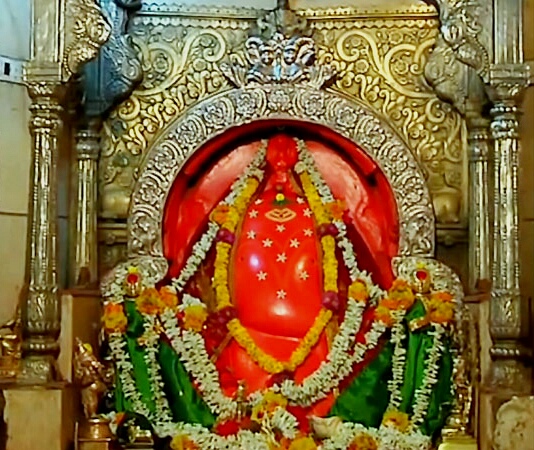
Shri Moreshwar, Morgoan-
1st Ashtavinayak -Photo By GPN
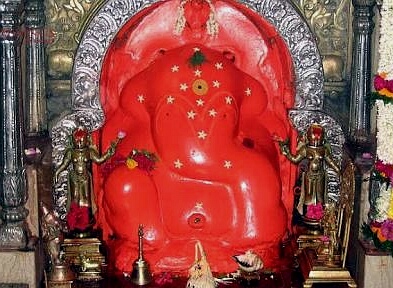
Shri Moreshwar, Morgaon (Diety Photo Original without attire and décor) 1st Ashtavinayak -Photo By GPN
Ashtavinayak- Moreshwar Morgaon
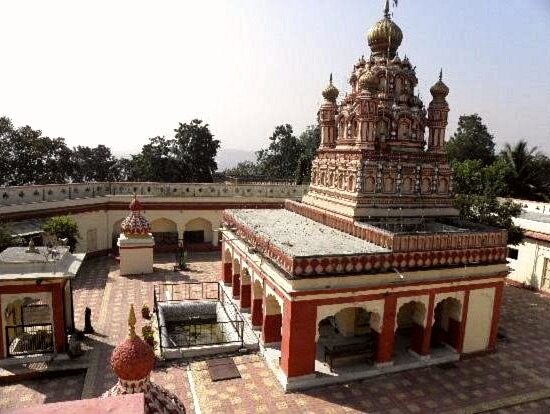
Shri Moreshwar Temple Morgaon, 1st Ashtavinayak -Photo By GPN
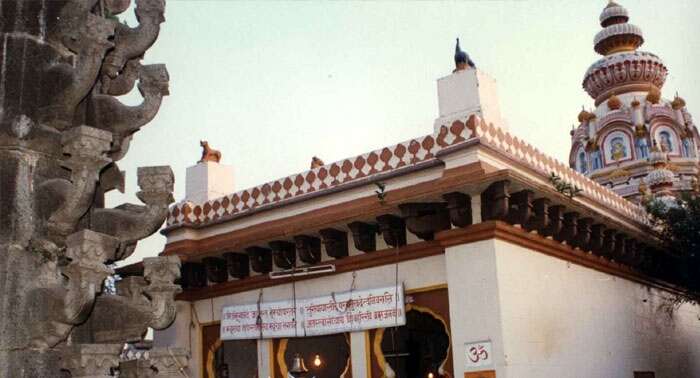
Shri Moreshwar Temple Morgaon, 1st Ashtavinayak -Photo By GPN

Main Gate of Shri Moreshwar Temple Morgoan, 1st Ashtavinayak -Photo By GPN

Inside Second Gate of Shri Moreshwar Temple Morgoan, 1st Ashtavinayak
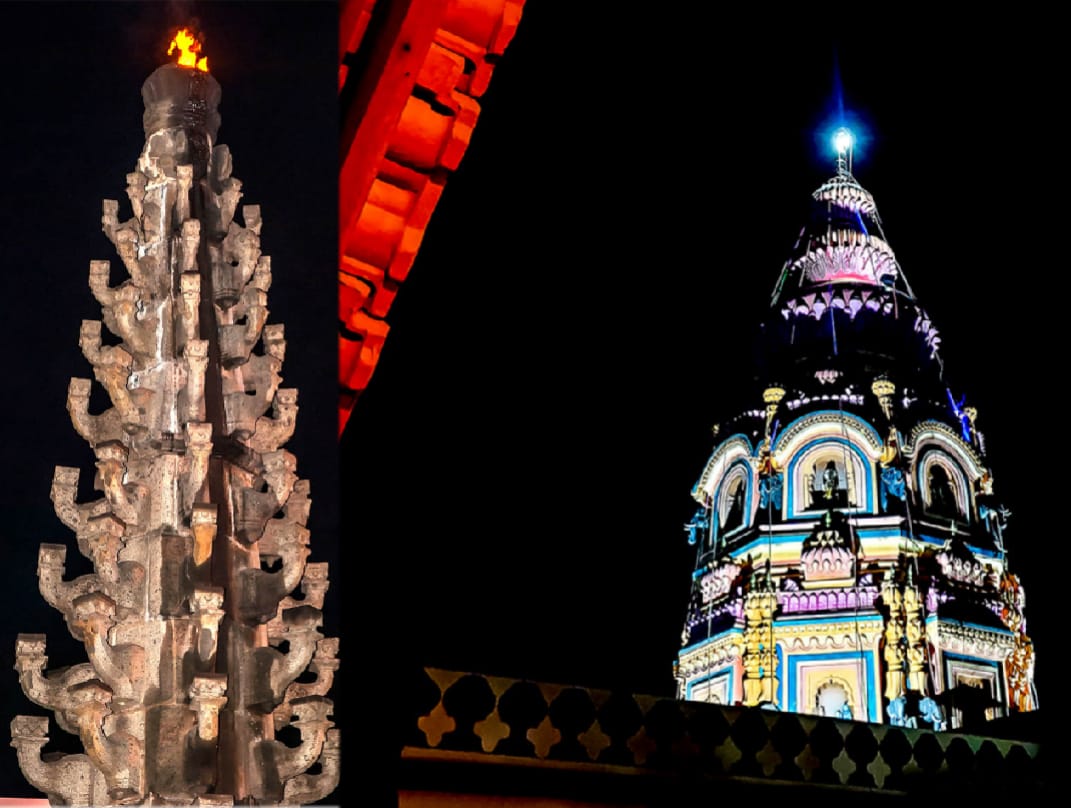
Night view of Deepstambh of Shri Moreshwar Temple Morgoan, 1st Ashtavinayak -Photo By GPN
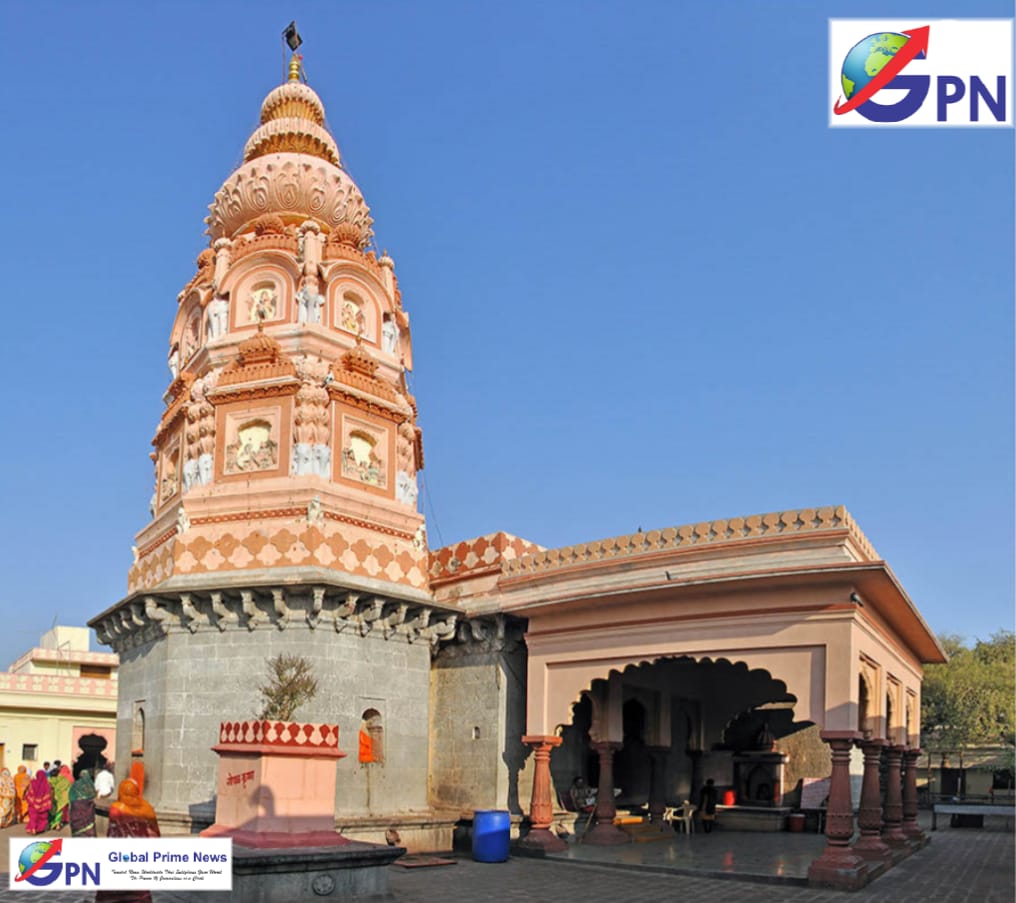
Shri Moreshwar Temple Morgoan, 1st Ashtavinayak
Shri Moreshwar or Mayureshwar Temple is situated at a distance of 55 km from Pune, next to the Karha River in the Morgaon village in the Baramati Taluka of Pune district in Maharashtra. This region is also known as the Bhuswananda. Moregaon Village is said to have received its name as once upon a time the shape of this place was like a peacock and there was an abundance of peacock birds in this region. Literally Moregaon means ‘Village of Peacocks’ and is a combination of two words (more which means Peacock and goan which means village).The place is very beautiful and the right time to visit is in rainy season as you can see a lot of peacocks at Moreshwar.
LEGEND of 1st Ashtavinayak -Shri Moreshwar Morgaon:
As per the legend Lord Ganesh riding a peacock in the form of Mayureshwara slew the demon Sindhu in response to pleas from the Gods. This is the first Temple to be visited during the Ashtavinayaka Temple Pilgrimage.
It is the most important of all the eight Ashtavinayak temples and has four gates. This idol has its trunk turned to the left and a cobra poised over it to protect it.
This form of Ganesha also has two other murtis of Siddhi (Capability) and Riddhi (Intelligence).
However, this is not the original Idol -which is said to have been consecrated twice by Brahma, once before and once after being destroyed by the asura Sindhurasur. The original murti, smaller in size and made of atoms of sand, iron, and diamonds, was supposedly enclosed in a copper sheet by the Pandavas and placed behind the one that is currently worshiped.
The original idol of Moreshwar was very small in size. It looks bigger as the layers of sindoor are applied on it. It is believed that this layer of sindoor peels off on its own every 100 or 150 years, revealing the actual idol. It is heard that the Mayureshwar’s armour was peeled off in 1788 and 1822 AD.
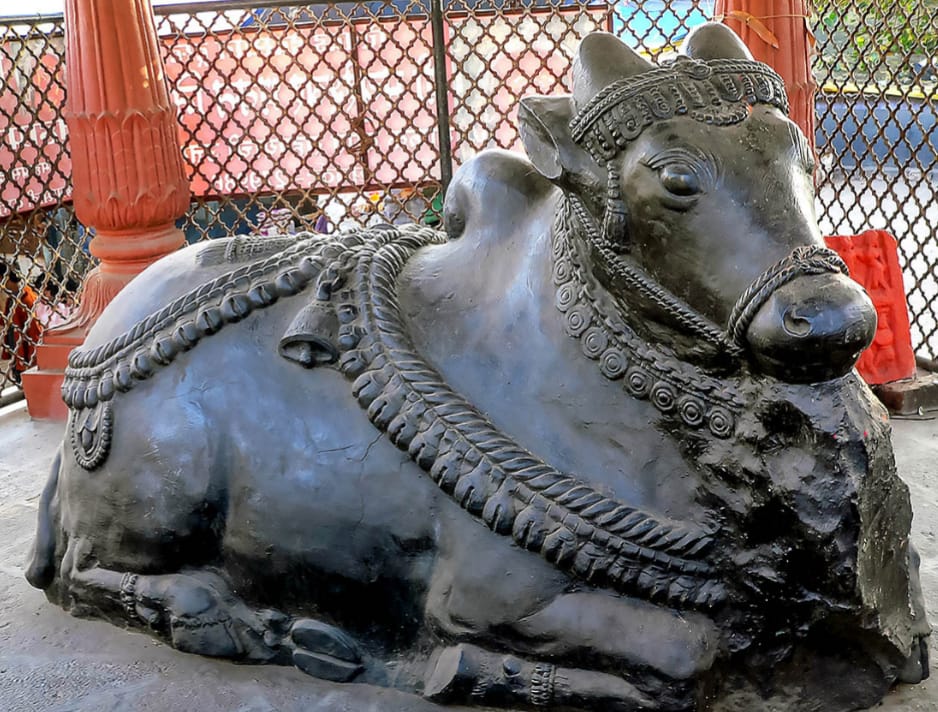
Nandi at Shri Moreshwar Temple Morgaon
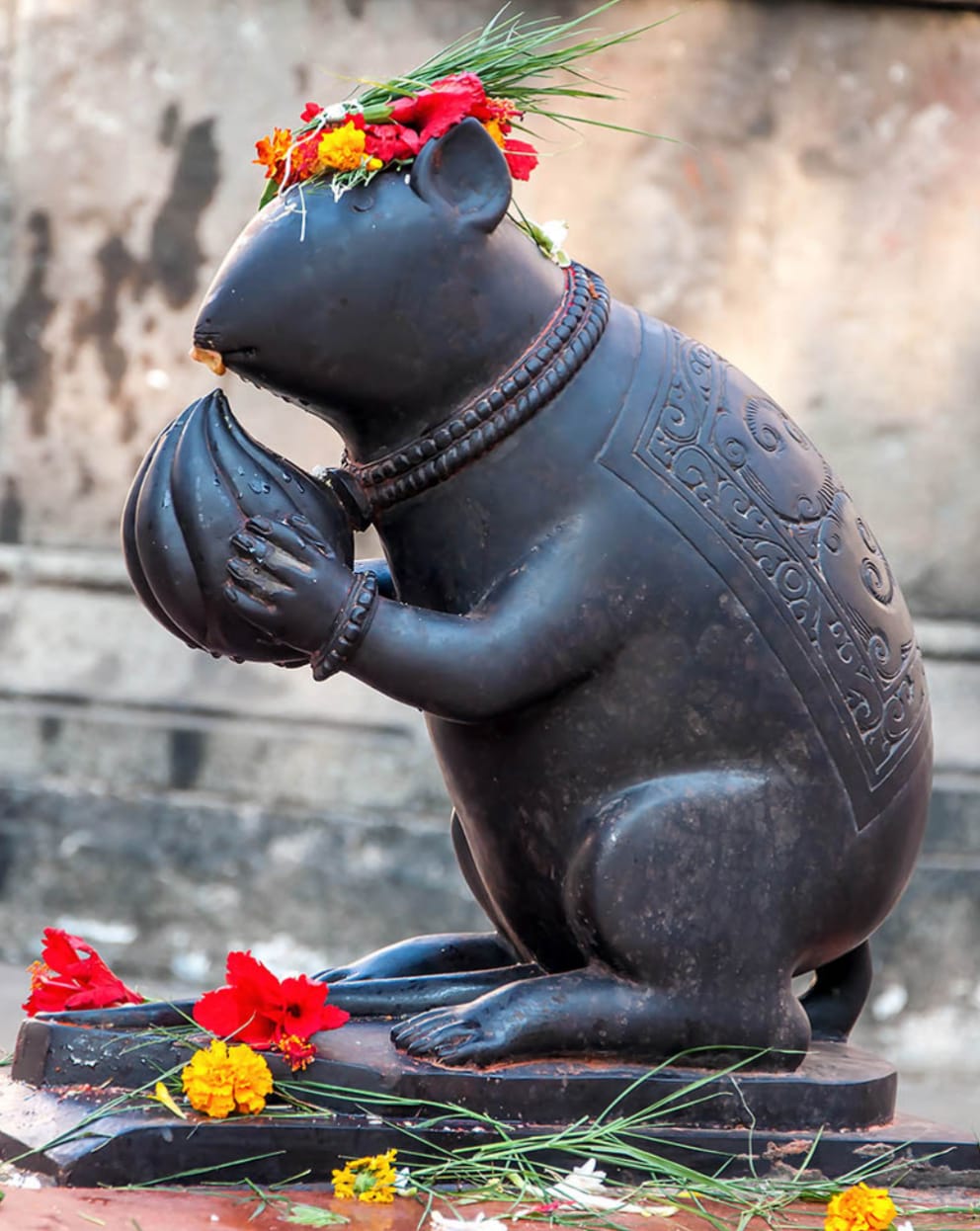
Mushak at Shri Moreshwar Temple Morgaon -Photo By GPN
The Puja Schedule at Shri Mayureshwar Ashtavinayak temple is given below:
* The temple is open for the pilgrims and tourists from 5 A.M. to 10 P.M.
* The first puja of the day also called as Prakshal Puja is done at 5 A.M. comprising the water abhisheka and flower offerings.
* Shodoshpchar Puja – This is another Puja which is conducted twice a day at 7 A.M. and at 12 Noon.
* Panchopchar Puja – This is performed at 8 P.M.
* The temple closes for the devotees after the Shejarti at 10 P.M.
* Naivedya – The food is offered to the deity thrice a day:
o In the morning Khichadi (made of Rice) is offered.
o In the afternoon the whole meal with sweets is offered.
* At night milk and rice is offered.
The devotees can perform the Pooja at this asthavinayak temple on their own.
Festivals celebrated at Shri Moreshwar Ashtavinayak temple:
One of the most popular festival celebrated at Moreshwar asthavinayak temple is the Ganesh Chaturthi. The other major festivals celebrated here are Bhadrapad Shuddh Chaturthi and Magh shuddh Chaturthi.
The other festival which is also celebrated here is the Vijaya DAshami festival.
The idol of Moreshwar is taken for procession around the village on the night of Vijaya Dashami. Anna Santarpana is observed on Magh Shuddh Panchami day. During this time, food is collected from every house of the village and the food offering is prepared. This is distributed among all the devotees.
2) SIDDHIVINAYAKA, SIDDHTEK
(2nd ASHTAVINAYAK):
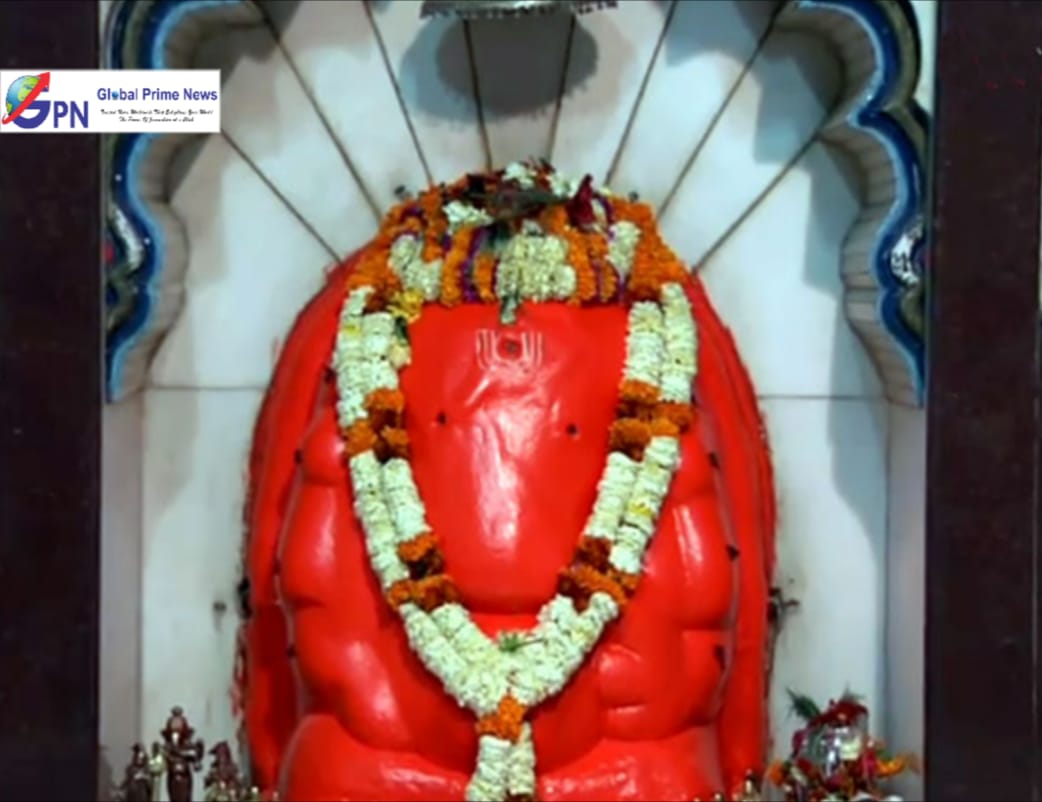
Shri Siddhivinayaka, Siddhatek-2nd Ashtavinayak- Photo By GPN
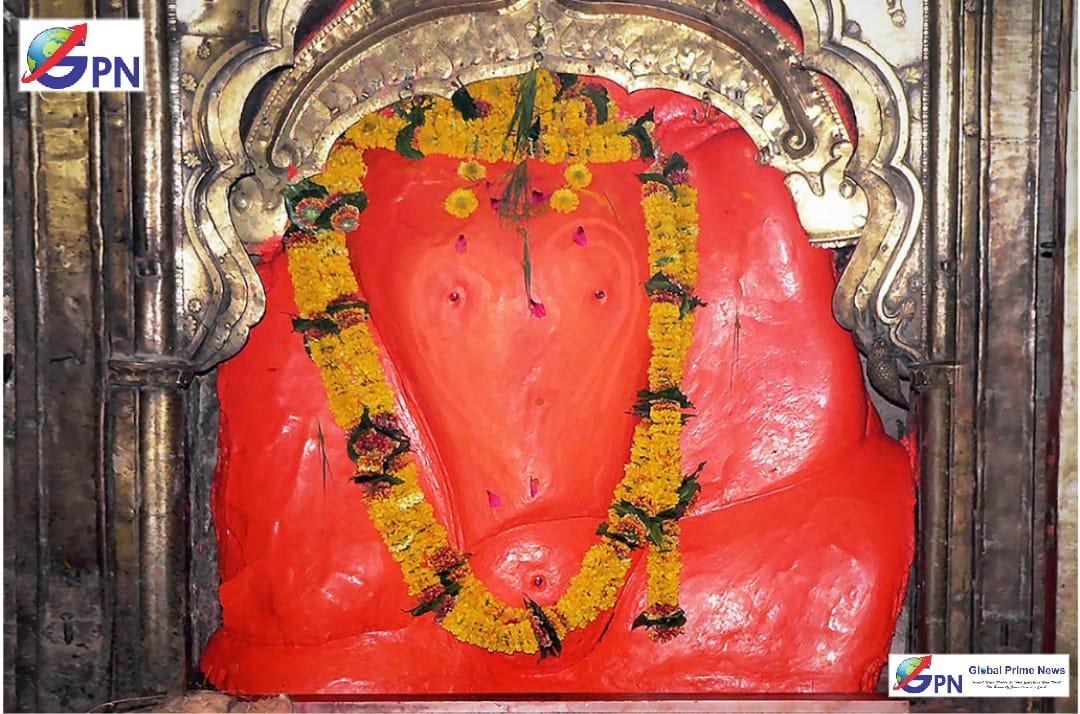
Shri Siddhivinayaka, Siddhatek-2nd Ashtavinayak- Photo By GPN
Siddhi Vinayak Temple is the second Ganesha Temple to be visited during the Asthavinayak Darshan tour.The only Ashtavinayak temple located in Ahmednagar district is known for the unique murti. It is the only idol among the eight idols which has the trunk positioned to the right.
This temple is located at Siddatek which is 20 Kms. away from Daund in Maharashtra. The temple is situated off the Pune-Solapur highway about 48 km from the town of Srigonda in Ahmadnagar district. The temple is located just next to Bhima River.
It is believed that the two saints Shri Morya Gosavi and Shri Narayan Maharaj of Kedgaon received their enlightenment here.
The idol of SiddhaVinayak temple is swayambhu and is three feet tall. The idol of SiddhaVinayak temple is facing north and his trunk is turned towards right.This is the only murti among eight Asthavinayakas with the trunk positioned to the right.
The swayambhu idol of Shree Siddhivinayaka at Siddhatek is placed in brass frame. We can see Brass idols of Jay & Vijay placed on both sides of Siddhivinayaka. We can see Riddhi and Siddhi sitting on one lap of Vinayaka. The face of the idol is very calm. The Pradakshana (circimnavigation) of the Siddhavinayaka is said to be very fruitful. We have to travel around 5 km. to complete one Pradakshana as the idol is attached to the hill itself.The Siddi Vinayak temple is situated next to the famous river Bhima. The amazing thing about this place is that this place is so silent that even the river Bhima dos not make any noise when flooded.We can see a small temple of Goddess Shivai in the sanctum. The inner sanctum, 15 feet high and 10 feet wide was built by Maharani Ahilyabai Hokar.This temple is under the control of Chinchwad Temple Trust.
While going towards Siddhivinayak temple after crossing river Bhima, you will see a place where Sage Vyas had performed Yagna(Sacrifices). It is believed that, years ago there was a heap of ashes from this sacrificial fire.
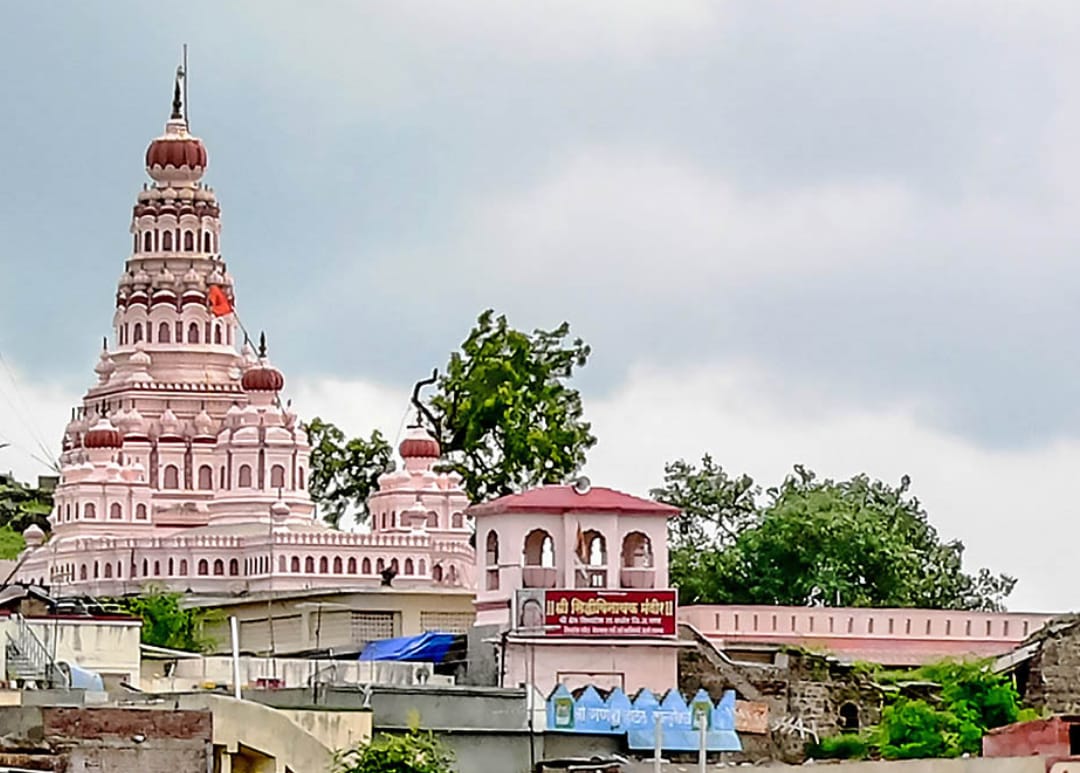
Shri Siddhivinayaka, Siddhatek Temple-2nd Ashtavinayak- Photo By GPN
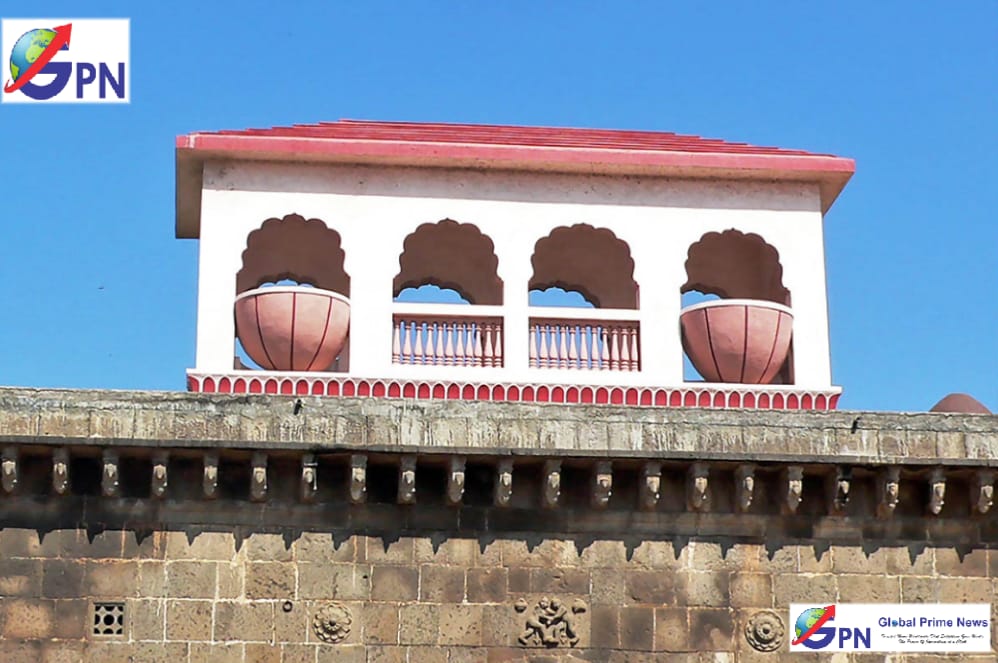
NAGARA DHOL at Shri Siddhivinayaka, Siddhatek Temple-2nd Ashtavinayak- Photo By GPN
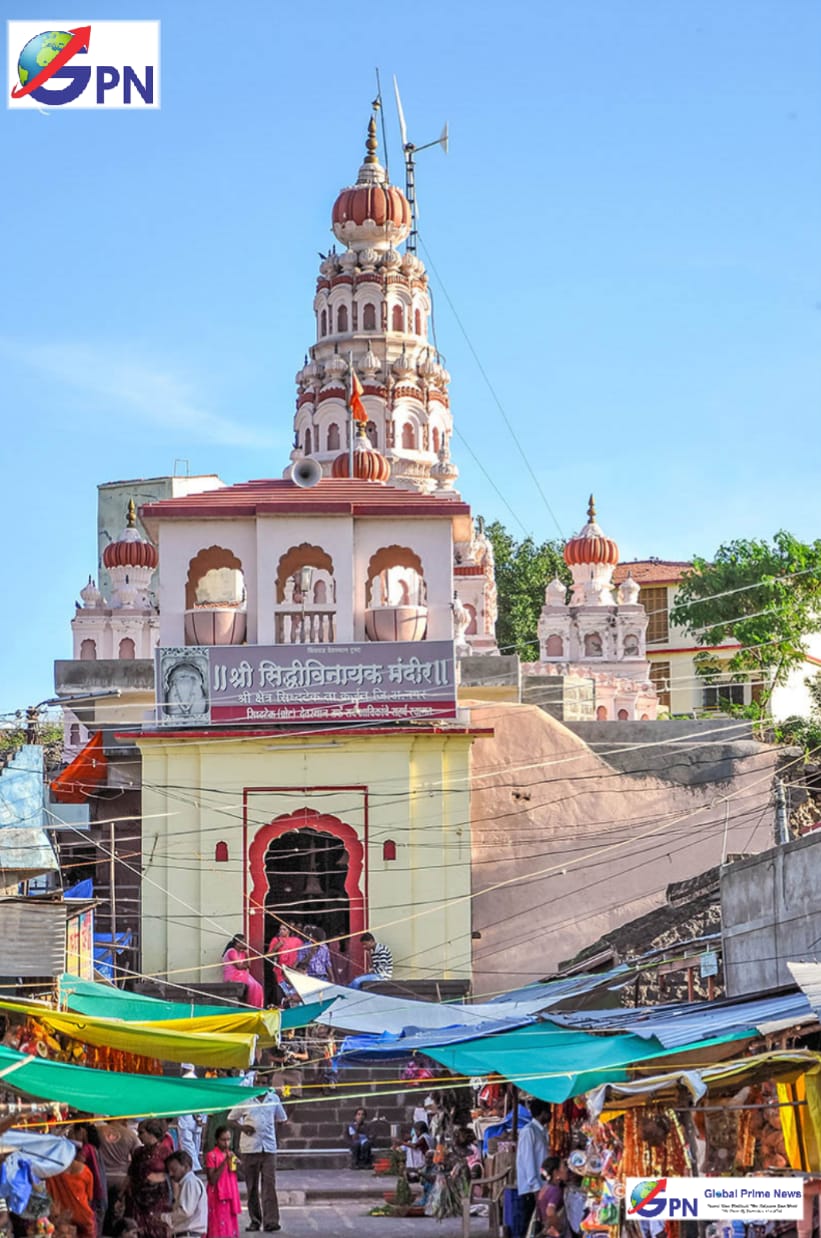
Shri Siddhivinayaka, Siddhatek Temple-2nd Ashtavinayak- Photo By GPN
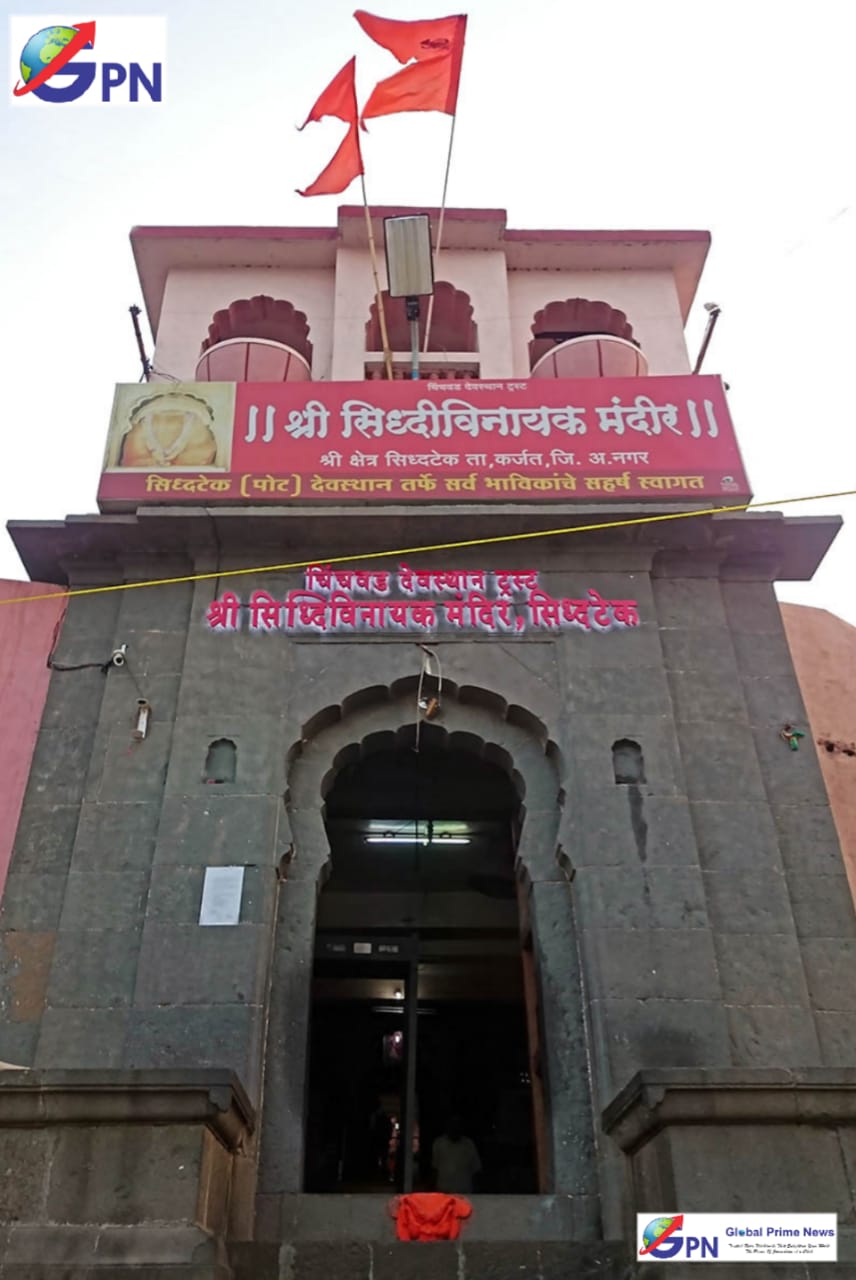
Main Gate at Shri Siddhivinayaka, Siddhatek Temple-2nd Ashtavinayak- Photo By GPN
LEGEND of 2nd Ashtavinayak- Shri Siddhivinayaka, Siddhatek.
The legend says that Siddhatek is a place where Lord Vishnu achieved Siddhi and thereby killed the demons Madhu and Kaitabha who were battling for thousand years. Long long ago Lord Brahma wanted to create Nature and for that he was chanting the alphabet “OM”. Lord Ganesha was delighted with the penance and gave him the boon that he will fulfill the wish of creating Nature. When Lord Brahma was creating Nature, Lord Vishnu fell asleep. The demons Madhu and Kaitabh emerged from God Vishnu’s ears. They started harassing all the Gods and Goddesses. Lord Brahma realized that only Vishnu will be able to kill these demons. Vishnu tried but could not kill them.
Vishnu tried his very best to kill them but failed. He then stopped the battle and took the form of Gandharva and started singing. Lord heard this singing by Vishnu and called Vishnu and Vishnu then told him about his unfinished battle with the demons. Shiva then advised him to recite the Shadakhar Mantra ( Om Ganeshaya Namah) and said he will wiln the battle. Lord Vishnu choose Siddhatek to complete this ritual of propitiating Ganesh. Ganesh then granted him his wish. Lord Vishnu then created a four-door temple on the hill and installed the statue of Ganesha. Since then Lord Vishnu achieved Siddhi and this place was called as Siddhtek or Shddhkshetra. Lord Brahma got the energy to create Nature with Lord Ganesha’s boon. Lord Ganesha accepted the two daughters of Lord Brahma as his wives. The temple created by Lord Vishnu perished in the course of time. It is believed that a shepherd saw Lord Ganesh here and started worshipping him. He then found a priest to conduct the worship and ultimately it was during the rule of the Peshwas sometime that this temple was erected again.
Puja Schedule at Siddhi Vinayak Temple at Siddhatek is given below:
* The doors of the Siddhivinayak temple are opened at 4am.
* The Saharan Puja is carried out between 4:30 AM to 5:00 AM
* The Lord is offered Khichidi at 10:00 AM
* The Panchamriti Puja is conducted at 11:00 AM
* The Mahabhog is offered at 12:30 PM
* The third puja commences after the sun set
* The Dhoop Aarti is carried out between 8:30 PM to 9:15 PM. The temple is closed to the devotees after this and the deity takes rest.
There is a lodging and boarding facility available near the temple. The rate for single room for one day is Rs.75/- and Rs.251/- for a big hall. Shree Gajaanan Purohit who is an ancestral Poojari of this temple also arranges a very good lodging and boarding.
Festivals Celebrated at Siddhi Vinayak Temple at Siddhatek:
Festivals are celebrated at Siddhi Vinayak Temple during the months of Bhadrapad and Magh from the Pratipada to Panchami of the waxing period of the moon. A procession of the Palki is carried out during these days after the Mahapuja and Mahabhog. This happens in the evening after 8 PM. Bhajans are also sung and Dhoop Aarti and Shej Aarti are also held. The Siddhi Vinayak temple at Siddhatek is visited by thousands of devotees during the festivals of Ganesh Chaturdhi, Vijaya Dashami and Somvati Amavasya.
3) BALLALESHWAR, PALI -(3rd ASHTAVINAYAK):

Shri Ballaleshwar Pali – 3rd Ashtavinayak -Photo By GPN
1)Moreshwar – Moregaon, 2) SiddhiVinayak-Siddhatek, 3) Ballaleshwar-Pali, 4) VardaVinayak- Mahad, 5) Chintamani-Theur, 6) Girjatmaj-Lenyandri, 7) Vignahar or Vigneshwar -Ozar, 8) Maha Ganapati – Ranjangaon and then again Moregaon.
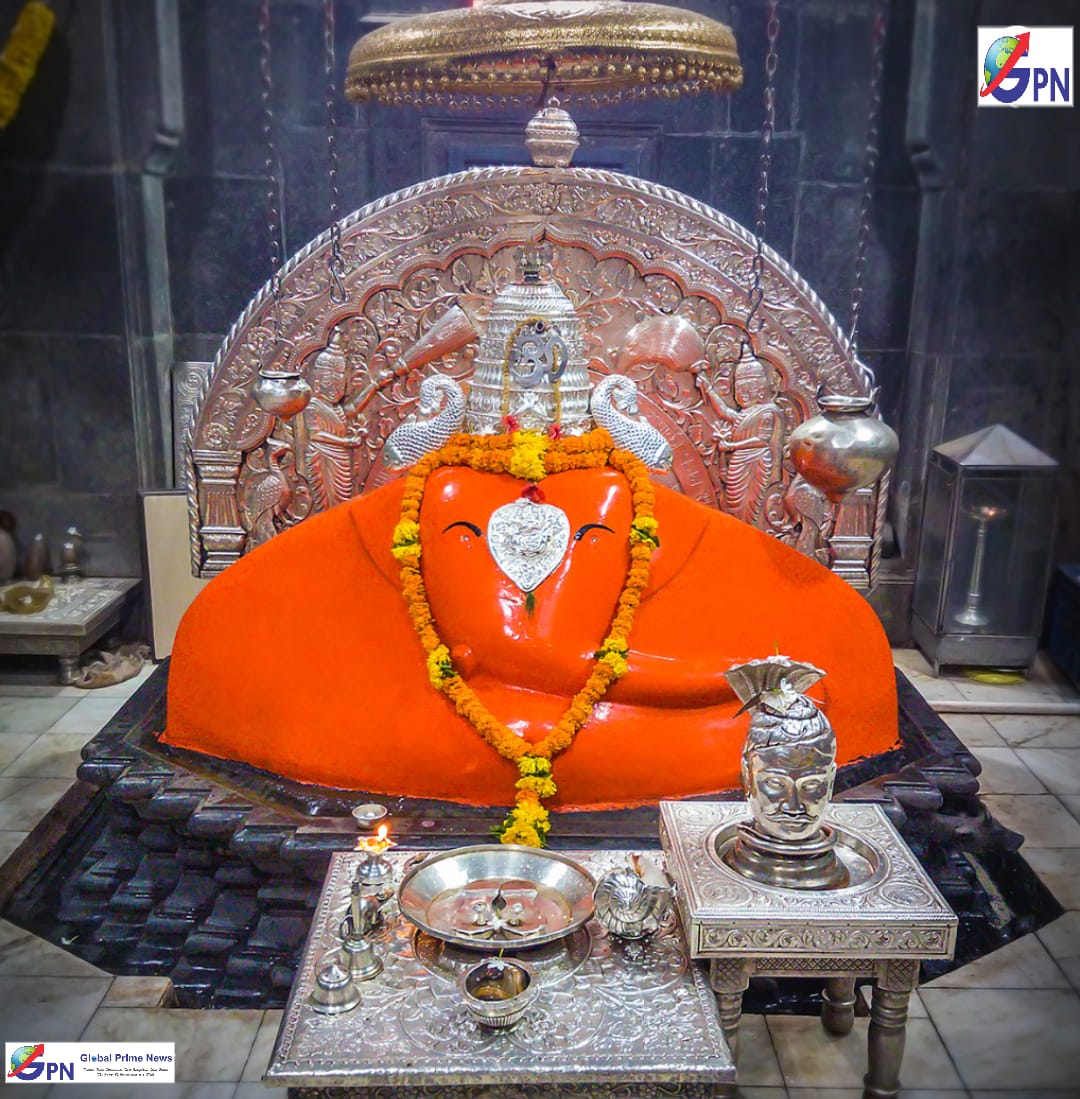
Shri Ballaleshwar Pali – 3rd Ashtavinayak -Photo By GPN
This Ballaleshwar temple is the only temple of Ganesh, famous by the name of his devotee. The temple is located in Pali, off the Mumbai-Pune highway, about 11 km before Nagothane on Mumbai-Goa highway.
The temple is constructed in such a way that after the winter (dakshinayan : southward movement of the sun) solstice, the sun rays fall on the Ganesha murti at sunrise. The temple is built with stones which are stuck together very tight using melted lead.
Like a few other murtis, this one has diamonds embedded in the eyes and navel, and with His trunk pointing to the left.
One speciality of this temple is that the prasad offered to this Ganapati at Pali is Besan Laadu instead of Modak that is normally offered to other Ganapatis.
The shape of the idol itself bears a striking semblance with the mountain which forms the backdrop of this temple. This is more prominently felt if one views the photograph of the mountain and then sees the idol.
Ashtavinayak Temple – Ballaleshwar Pali
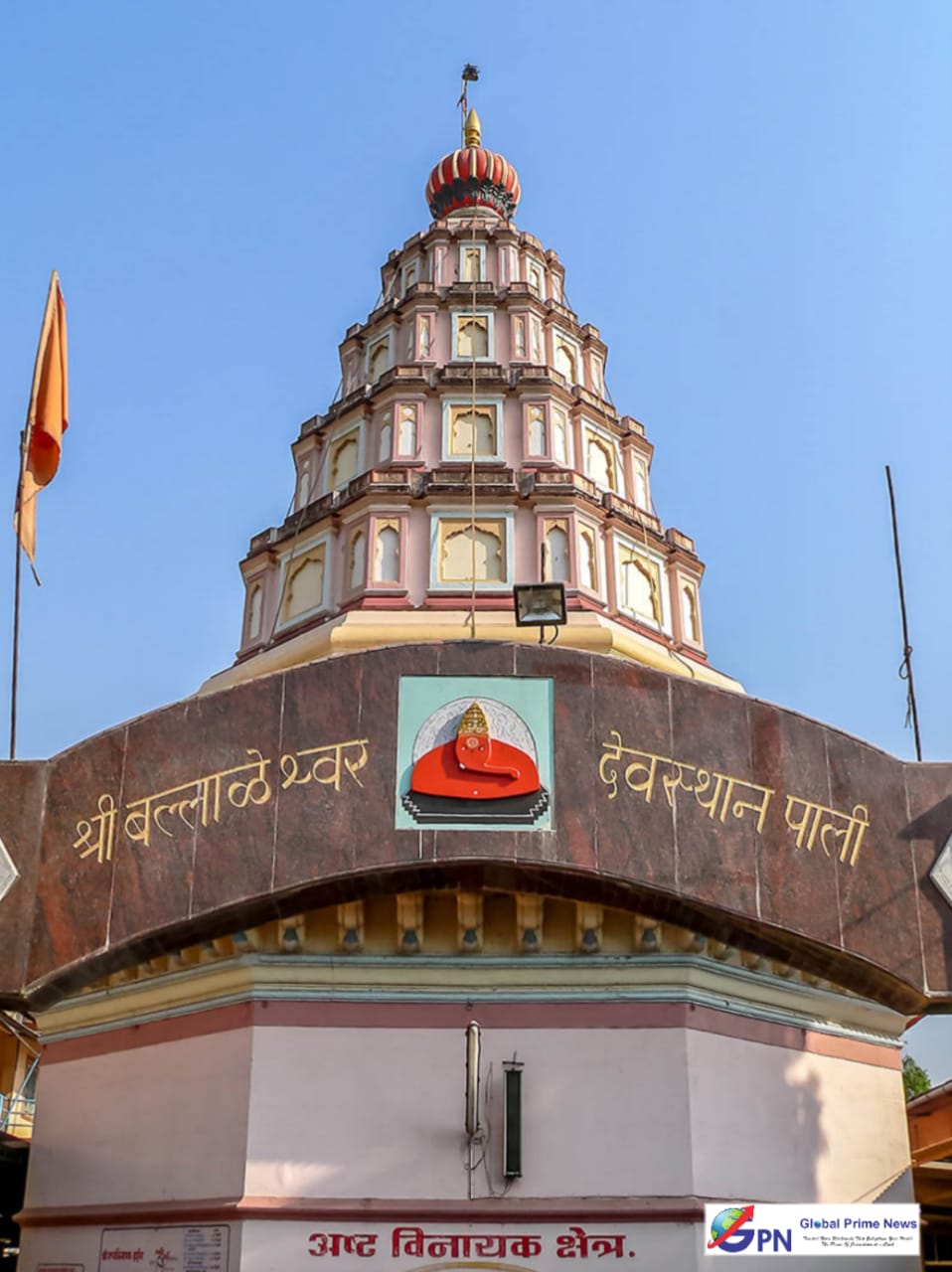
Shri Ballaleshwar Temple, Pali – 3rd Asthavinayak -Photo By GPN
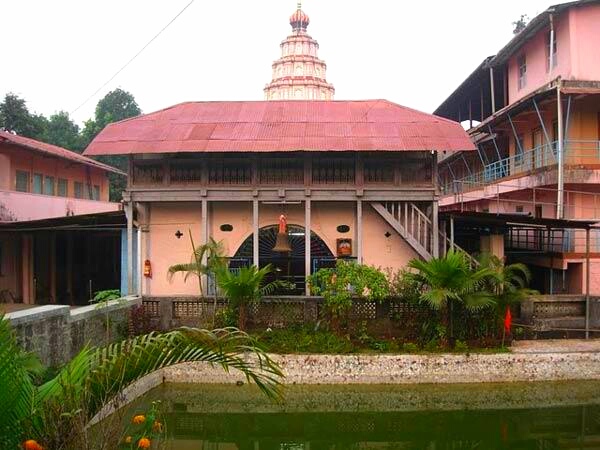

Shri Ballaleshwar Temple, Pali – 3rd Asthavinayak -Photo By GPN
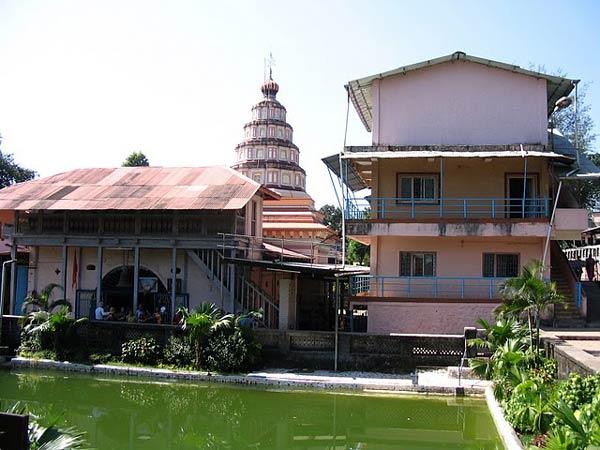
Shri Ballaleshwar Temple, Pali – 3rd Asthavinayak -Photo By GPN
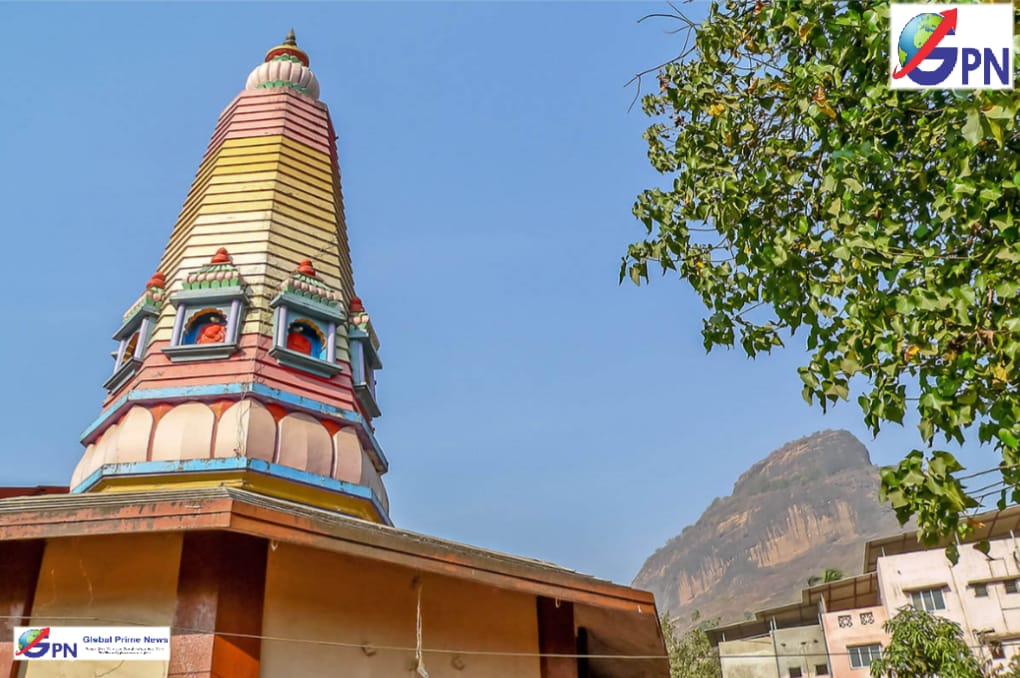
Shri Dhundivinayak Temple, Pali – 3rd Asthavinayak it is behind Shri Ballaleshwar Temple -Photo By GPN
Ballaleshwar temple opens at 5 AM in the morning and the devotees can start worshiping the Lord Ballaleshwar from 5:30 AM onwards.
* The Kakad aarti and Panchopachari Puja are done by the priest at 5:00 AM
* Shodopachari Puja is conducted before 12:00 PM in the after noon.
* The Panchamriti Puja is conducted after sun set.
* The Dhoop Aarti is conducted at night
* The temple is closed for the devotees after the last puja and after this the deity takes rest.
On giving appropriate money, the temple poojari will perform Abhishek, Pooja and Sahastravartan. Devotees can offer the following Puja –s at the temple.
* Sahastravartan = Rs 151/-
* Laghurudra Avartan = Rs 121/-
* Puja and Ekadshani = Rs 11.25/-
* Mahapuja = Rs 75/-
* Abhishek Puja = Rs 5.25/-
The Temple Trust Provide Staying Options with 24 Rooms & 2 Halls.
Bhaktnivas No 1 : Total No of Rooms – 10 Charges per room Rs.250 ( 5 pax in a room )
Bhaktnivas- 2 : 14 Rooms Rs.300
2 Halls Rs.10 per person .
Meals : Purchase coupon from Temple Office for Rs.10 ( Till 1.30 PM )
Festivals celebrated at Ballaleshwar Vinayak temple at Pali
Two major festivals are celebrated at Ballaleshwar temple at Pali. The first one is celebrated in the month of Bhadrapad in the waxing period from Pratipada to Panchami and the second one in Magh month of the waxing period from Pratipada to Panchami.
The festivals on these are celebrated for five days. Programs like Kirtans, religious discussions and other cultural activities are organized during these festivals. A Mahabhog is offered to the Ballaleshwar on Chaturthi day. According to a popular belief here, one can see the impression of God’s fingers on the offerings. Thousands of devotees come and visit this miracle event on this day. Dahikala and Anna Samtarpan are carried out on Panchami.
On the third day of Magh month, a procession carries the Palki of the deity around the village.
Legend of this Ashtavinayak is associated with the devotion of a boy called Ballala towards Lord Ganesh. He was the Son of Indumati and Kalyan Seth. Ballala was an ardent devotee of Lord Ganesh. One day Ballal alongwith other children ventured out of the village boundary for playing. They noticed a large stone with the resemblance of Lord Ganesha, Seeing this he organized a special pooja at the spot in his village- Pali. He invited all other children of that village to take part in that.The boys chanted various shlokas like ‘Vakratunda Mahakaya‘, ‘om gam ganapataye namaha’ etc. and Ganesh Sahasranaam.
The pooja went on for several days and continued for months, devoted children refused to return home before the completion of the pooja by Ballala. This annoyed the parents; they complained to Kalyani Seth- father of Ballala. Kalyani seth went to the place where the pooja was taking place. He threw the Ganesh idol worshiped by the boy into some distance away and beat him up severely. A seriously injured Ballala, though tired, continued with chanting Lord Ganesh prayers. Pleased with the devotion of the boy, Lord Ganesh appeared before him and healed Ballala. The boy requested Lord Ganesh to take abode at his village. The Lord Ganesh agreed and told Ballala that he will be known here by the boy’s name.
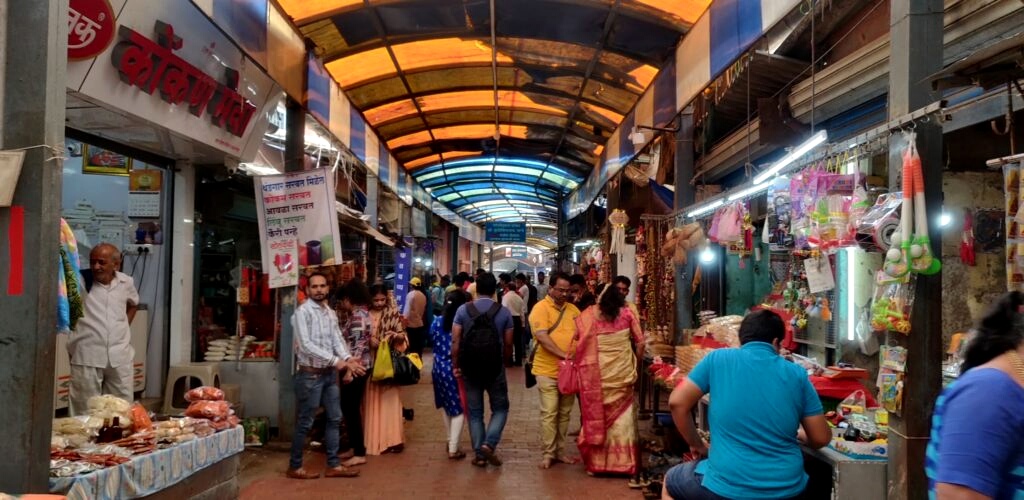
The way from Shri Dhundivinayak Temple that Leads to the entrance of Shri Ballaleshwar Temple is occupied by flower-prasad and other vendors – Photo By GPN
That Swayambhu Moorthi is called Ballaleshwar. The Swayambhu stone idol which Kalyani Seth threw to the ground is also known as Dhundi Vinayak.From the Dhundi Vinayaka temple leads a way to the main temple.This Dhundivinayaka is a swayambhu murti and is worshiped before Ballaleshwar is worshiped.
4) VARADAVINAYAK, MAHAD –
(4th ASHTAVINAYAK)
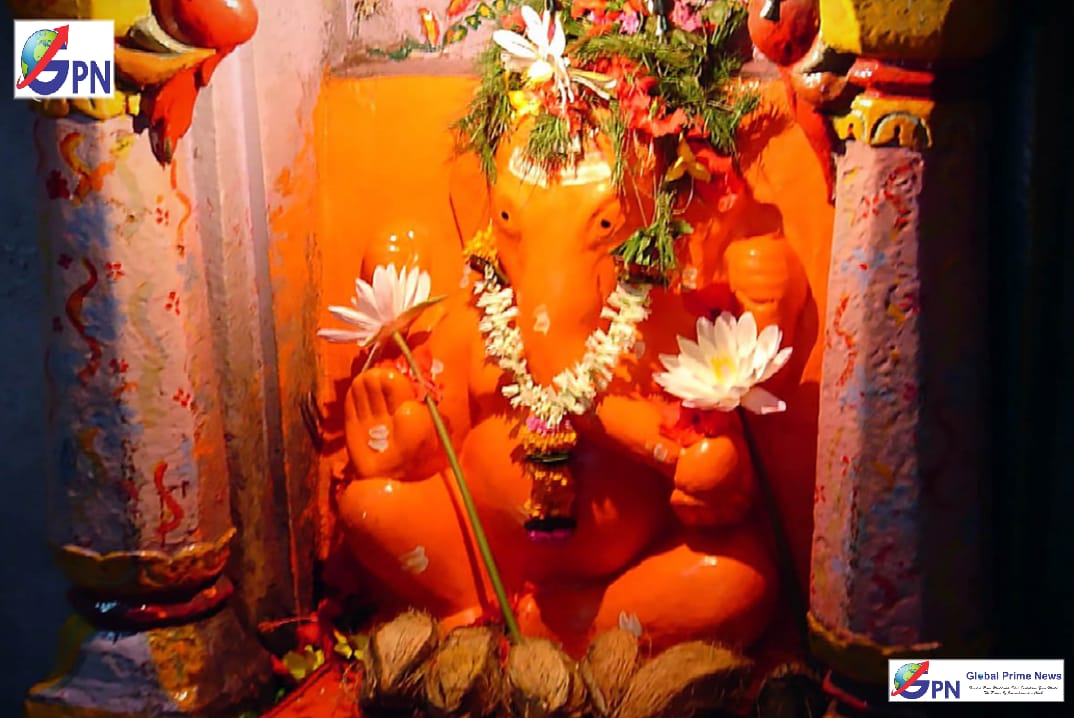
Shri Vardavinayak, Mahad –
(4th Ashtavinayak) -Photo By GPN

Shri Vardavinayak, Mahad –
(4th Ashtavinayak) -Photo By GPN
Ganesh as Varada Vinayak fulfills all the dreams and desires plus grants all the boons. This temple is located three kilometers off the Pune-Mumbai highway near Khopoli (80 km from Pune) and is thus closest to Mumbai city.
The idol faces the east, has its trunk to the left and has been in the constant company of an oil lamp – said to be burning continuously since 1892. There is an elephant idol on each side guarding the temple on all 4 sides. The hall is 8feet by 8feet. The dome is 25feet high and is golden at the top. The dome has designs of cobra.
This temple was built by Subhedar Ramji Mahadev in year 1725. We can also see the idols of Mushika, Navagraha Devtas an Shiva linga at this temple. We can see the Gomukh from which the holy water flows. We can see a holy pond on the west side.
This is the only Asthavinayak temple where the devotees are allowed to personally pay their homages and respects to the idol of Ganesha. They are allowed in the immediate vicinity of the Ganesha idol to perform their puja.
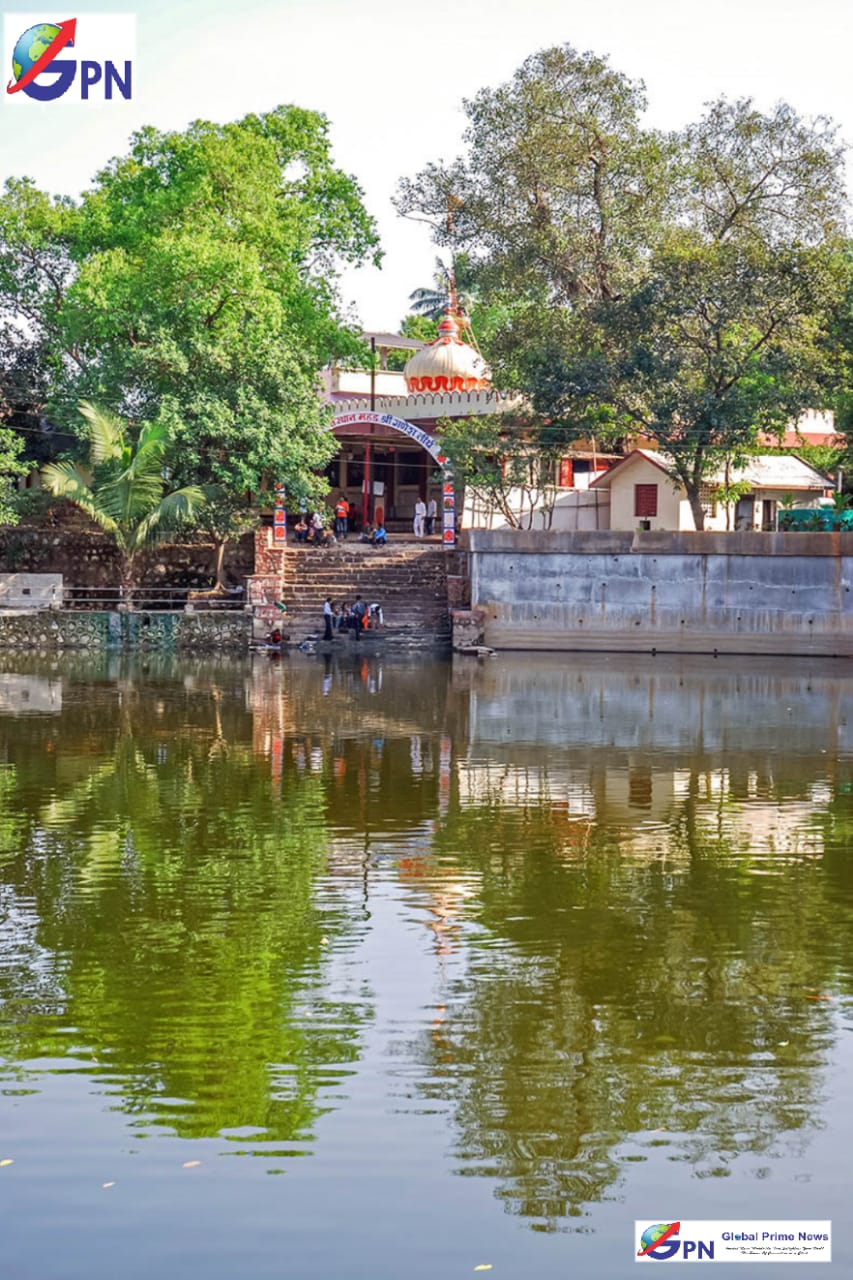
Shri Varda Vinayak (Shri Maha Ganapati) Temple , Mahad (Raigad) -Photo By GPN

Shri Varda Vinayak (Shri Maha Ganapati) Temple , Mahad (Raigad) -Photo By GPN
LEGEND of Shri Vardavinayak also Known as Shri MahaGanapati of Mahad
The Legend says that the childless great king, Bhima of Koundinyapur and his wife met Sage Vishwamitra when they came to forest for penance. Sage vishwamitra gave them Ekashar Gajana Manthra to chant and the prince Rukmanda was born to them. Soon Rukmanda grew up and became young prince.Prince Rukmanda while on his hunting trip stopped at the hermitage of Rishi Vachaknavi. Rishi’s wife Mukunda fell in love with Prince Rukmanda and expressed her desire.
The handsome Prince Rukmanda refused sage Vachaknavi’s wife Mukunda’s illicit call, and was cursed to suffer from leprosy. Later, Rukmangada’s leprosy was cured by bathing at the Kadamba pond.
Mukunda felt very much lovesick. Knowing her plight, Lord Indra took the form of Rukmanda and had pleasure with her. As a result Mukunda bore a child by name Gritsamad. When Gritsamad came to know about the real story he cursed his mother Mukunda to become the tree of Bori and she in turn cursed him to bore a demon son.
Gritsamad after getting cursed went to the forest of Pushpak and worshipped Ganesha.Lord Ganesha contented with his penance tells him that he will get a brave son who cannot be defeated by anybody other than Lord Shiva.
Gritsamada asked Ganesh to stay there permanently and asked for knowledge of Brahma. The forest is called as Bhadraka today. He built a temple at this place and the idol installed there in the temple is called as Varada Vinayaka. There is a belief that if the coconut received as prasad during Maghi Chaturthi is consumed, you will be blessed with a son. Hence there is a heavy rush of devotees during the Maghi Utsav to this Asthavinayak Temple.
Gritsamad is famous for the mantra ‘Gananan Tvaam Ganapatim Havamahe’ . He founded the temple and called this Ganesha: Varada Vinayak.
Puja Schedule:
* A unique opportunity is given to any devotee who donates Rs.31,000/- to the temple. Such a devotee is given the entire day during which he can worship Lord Varada Vinayak as he likes and also he can run the temple for that day in the way he would wish. The devotee along with his family members can worship the lord during the whole day. The temple priests will not interfere in any way for that day.
In the month of Bhadrapad shuddh ( the waxing period) from first day to panchami and in the month of Magh shuddh till panchami, major festivals are celebrated in this temple.
5) CHINTAMANI, THEUR – 5th ASHTAVINAYAK:
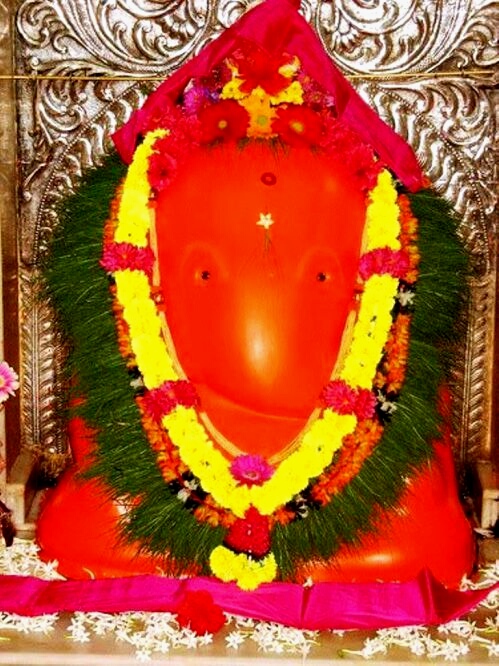
Shri Chintamani, Theur
5th Ashtavinayak – Photo By GPN
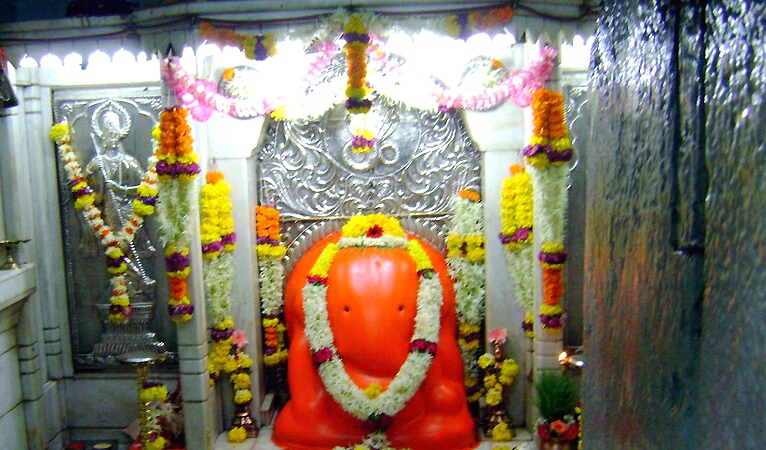
Shri Chintamani, Theur
5th Ashtavinayak – Photo By GPN
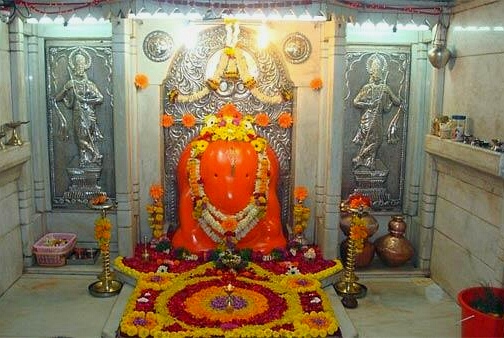
The idol of Chintamani Vinayak is facing east direction and is Swayambhu (Self emanated) and is not sculpted by human hands. The idol has the trunk turned towards left side. You can also see carbuncle and diamonds in the eyes of Lord Chintamani Vinayak at Theur -Photo By GPN
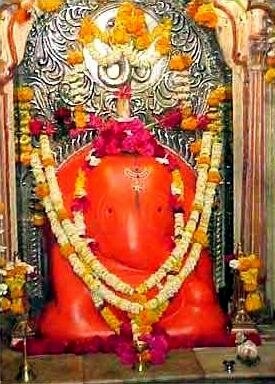
Shri Chintamani, Theur
5th Ashtavinayak – Photo By GPN
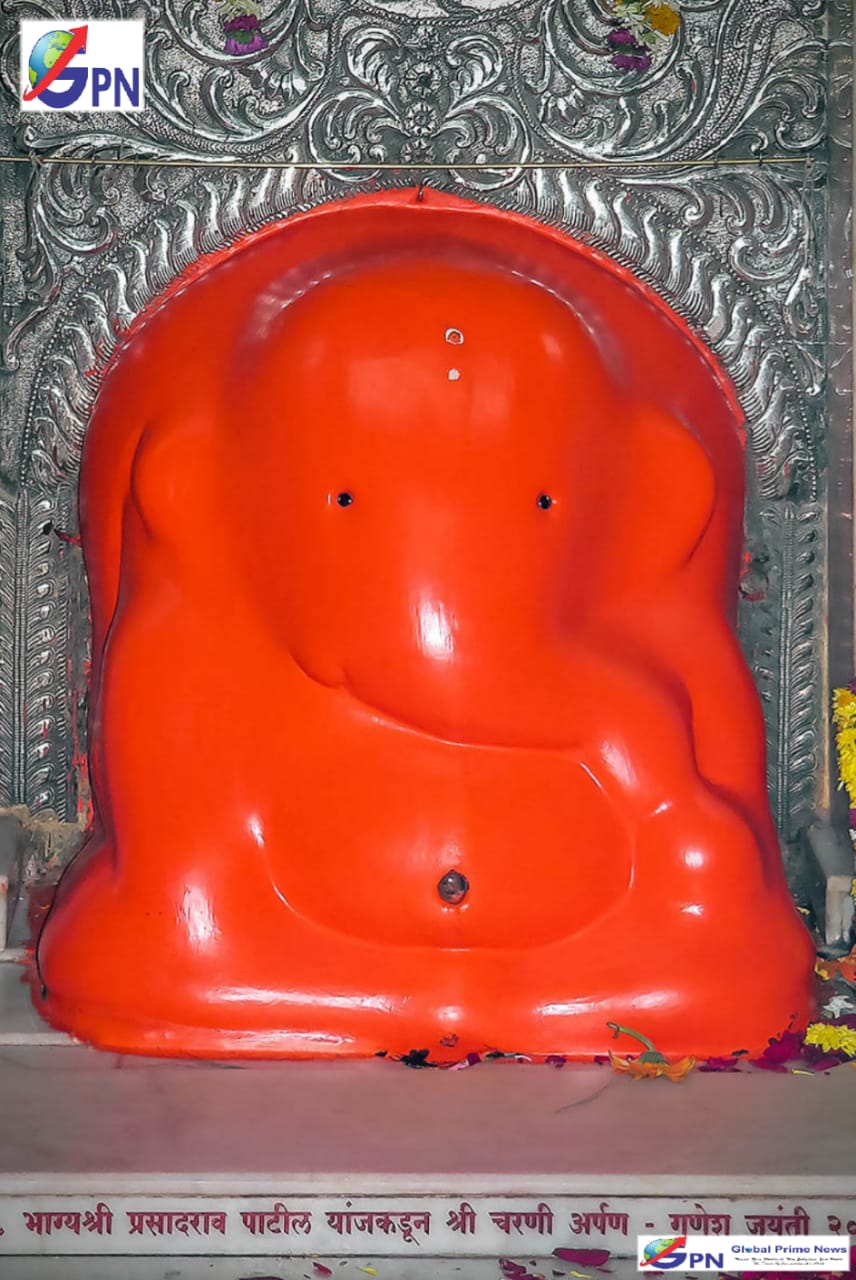
Shri Chintamani, Theur 5th Asthavinayak -Photo By GPN

Shri Chintamani, Theur 5th Asthavinayak -Photo By GPN
Ashtavinayak – Chintamani Theur
Ganesh as Chintamani is a god who brings peace of mind & drives away all the perplexities of the mind. Here the idol of Ganesha has a left trunk with carbuncle and diamonds as its eyes. The idol faces the East side.
Ganesha is believed to have got back the precious Chinatamani jewel from the greedy Gana for sage Kapila at this spot. However, after bringing back the jewel, sage Kapila put it in Vinayaka’s (Ganesha’s) neck. Thus the name Chintamani Vinayak. This happened under the Kadamb tree, therefore Theur is known as Kadambanagar in old times.
The temple is located 22 km from Pune, off the Pune-Solapur highway, and is hence the nearest from Pune. The village of Theur sits at the confluence of three major regional rivers—Mula, Mutha & Bhima.
Festivals celebrated at Chintamani Vinayak temple at Theur
There are major celebrations of festivals in the month of Bhadrapad Shuddh[ the waxing period] from Pratipada to Saptami [from the first to the sixth] and in the month of Magh Shuddh till the ashtami [eighth day] at Chintamani Vinayak temple at Theur. This festival is called the Dwaryatra .
Chintamani Vinayak temple at Theur village is around 22 km south-east of Pune and can be reached by road easily. Lot of buses are available from Pune Sarasbag or Poolgate bus stand to Theur. The nearest Railway Station is Pune Junction.
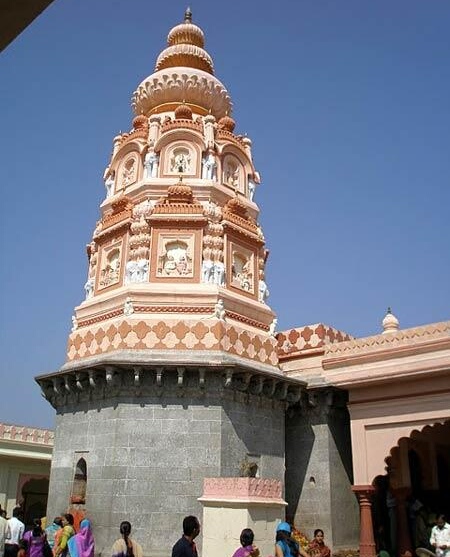
Chintamani Asthavinayak Temple, Theur, Pune -Photo By GPN
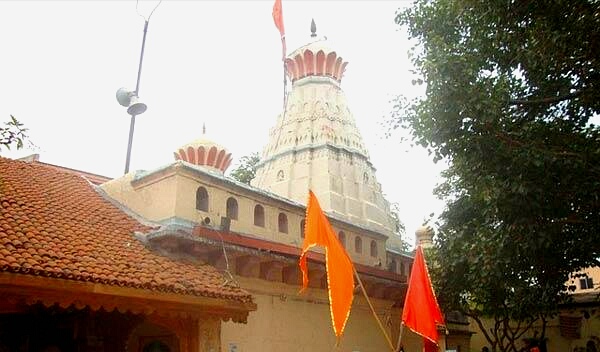
Chintamani Asthavinayak Temple, Theur, Pune -Photo By GPN

Chintamani Asthavinayak Temple, Theur, Pune -Photo By GPN
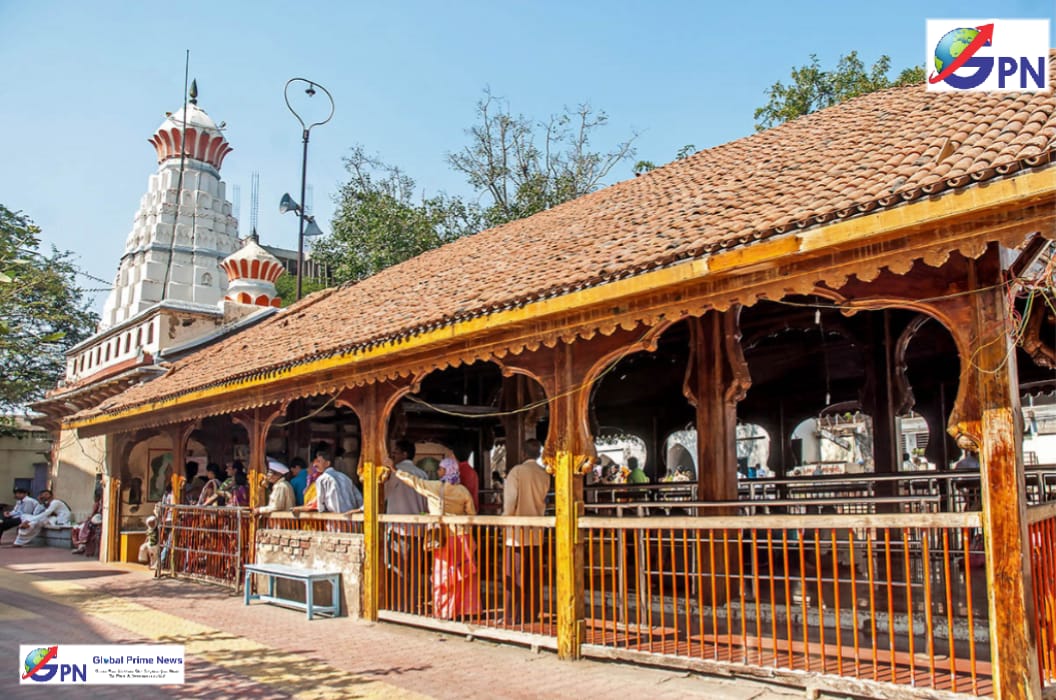
Shri Chintamani Temple , Theur – Photo By GPN
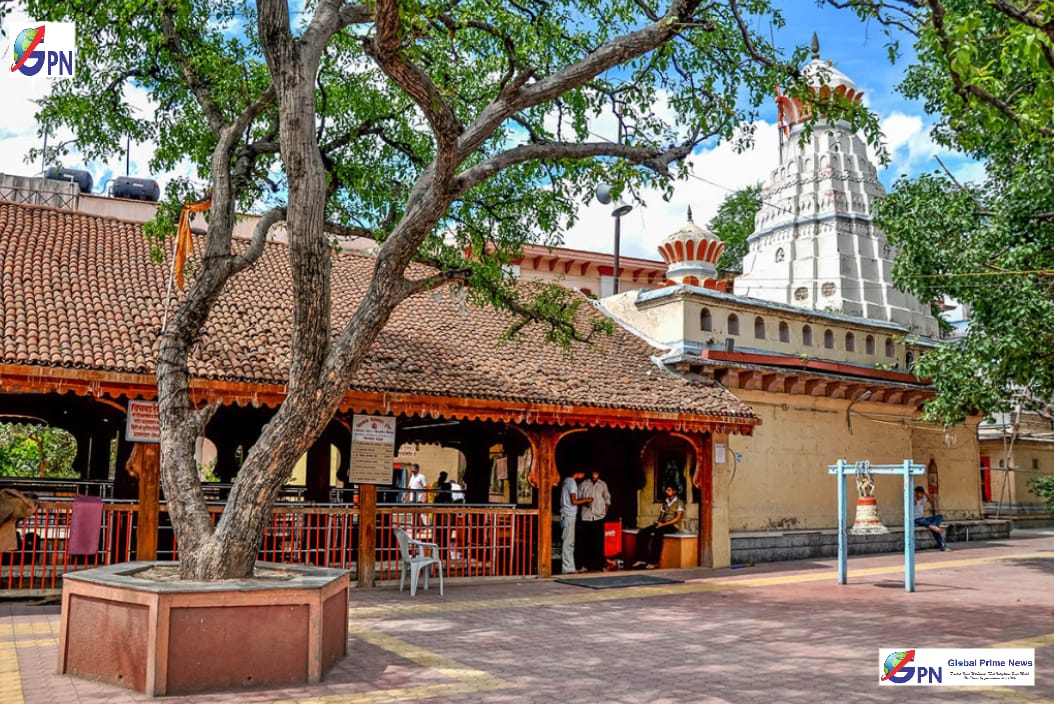
Chintamani Asthavinayak Temple, Theur, Pune -Photo By GPN
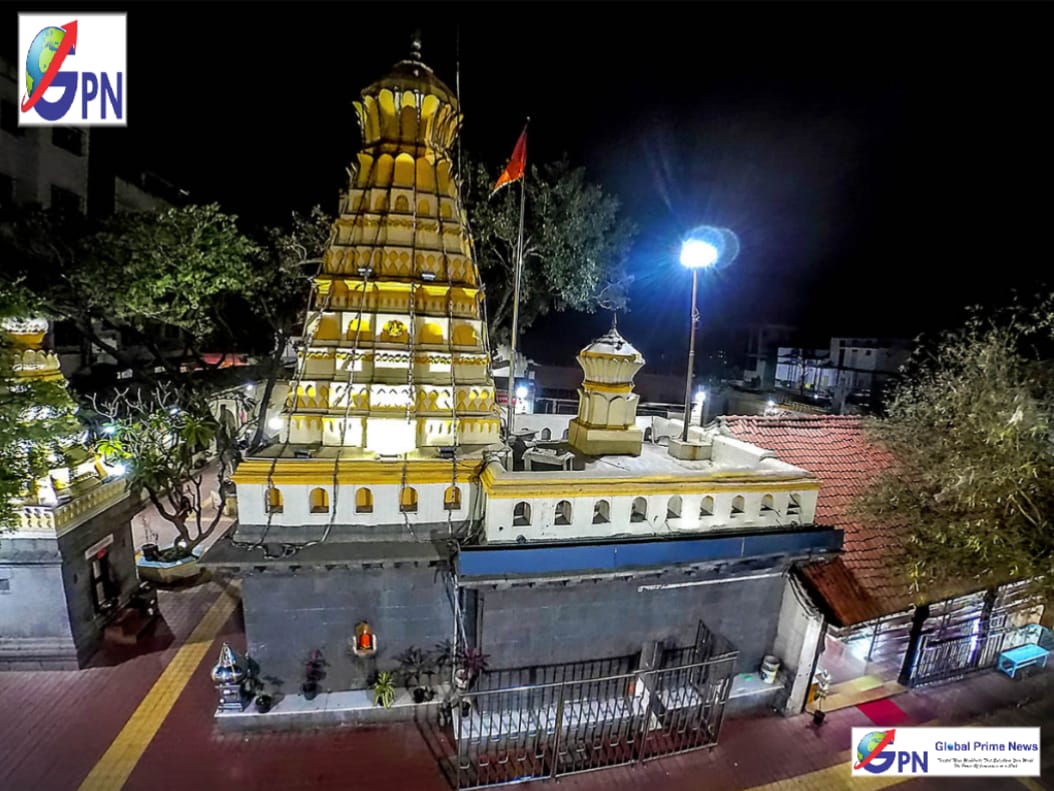
Chintamani Ashtavinayak Temple, Theur, Pune at Night-Photo By GPN
The Chintamani Vinayak temple was built during the rule of Peshwas by Sri Daharnidhar Maharaj Devji. The main Gate of the Chintamani Vinayak temple faces north and the temple has a temple hall made of wood. We can see a fountain made up of black stone in the hall. As Peshwas visited this place very frequently, one of the two five-metal bells bought from Europe from the church was kept here and the other bell was kept in Mahad. After the death of Madhav Rao Peshwa, his wife went for sati and a beautiful garden was made in her memory which is very attractive to see.
One of the interesting things about the Chintamani Vinayak Temple at Theur is that there is a separate section for meditation. It is called as a Overry. This kind of separate sections for meditation were found in very old temples. We can also see a small Shiva temple in the premises of this temple. We can see huge crowds seen at Chintamani Vinayak Temple during the vinayak Chaturthi Festival which is the birth day of Lord Ganesha.
LEGEND of Chintamani Vinayak temple at Theur
According to the Legend it is at this spot that Lord Ganesha is believed to have restored the precious Chintamani jewel from the greedy Prince Gana who stole it from Sage Kapila.
Abhijeet was a great and powerful king who did not have a son who would be the heir to his throne. The king and his wife carried out great penance at the suggestion of Rishi Vaishyampayane and were finally rewarded with son who they named Gana. He later came to be known as Ganaraja.
Prince Ganaraja was once invited to visit the ashram of Sage Kapil. The sage was a good host and with the help of the Chintamani Ratna [a precious stone] he was able to serve the best of food to Ganaraj. Impressed by the Chintamani ratna, Ganaraj wanted it for himself and asked the Sage to give it to him. But the Sage refused to give it to him. Ganaraj forcibly took it from the Kapil muni. Goddess Durga advised the sage to seek the help of Lord Ganesha.
On the prayers of the sage, Lord Ganesha had a battle with Ganaraj under a Kadamba tree and he got the Chintamani Gem back from Ganaraj and given back to the sage. But by that time Kapil muni lost all the desire to have the Chintamani gem with him and he offered it to Lord Ganesh. Kapil Muni tied the Chintamani Ratna around Lord Ganesh’s neck and so Lord Ganesh was known as Chintamani Vinayak. All these incidents took place under a Kadamba tree, Theyoor is also known as Kadamba nagar.
Chintamani Vinayak is associated with Lord Brahma. It is said that once Lord Brahma was feeling restless and called Vinayaka to ease his mind. As Lord Brahma’s worries (Chinta) were removed by the Chintamani Gem that Ganesha adorned Ganesha was thus known as Chintamani Vinayak one who could heal by removing pain, worries and obstacles.
Shri Chintamani is a family diety of Shreemant Madhavrao Peshwa. His palace was near the temple and now it is converted into garden. Madhavrao Peshwa had stayed in this palace in his last sickness. He renovated the temple and performed various religious programmes in the temple. By chanting Gajanan, Gajanan he bestowed his life on the foot of the Chintamani. Ramabai, wife of Madhavrao Peshwe became Sati (she burnt herself with the corpse of her husband). On that place, that is, on the bank of Mula-Mutha river Sati’s Vrindavan is built. That day was 18-11-1772, Kartik Vadya Ashtami. On this day Rama-Madhav death anniversary is celebrated every year.
6) GIRIJATMAJ, LENYADRI – (6th ASHTAVINAYAK)
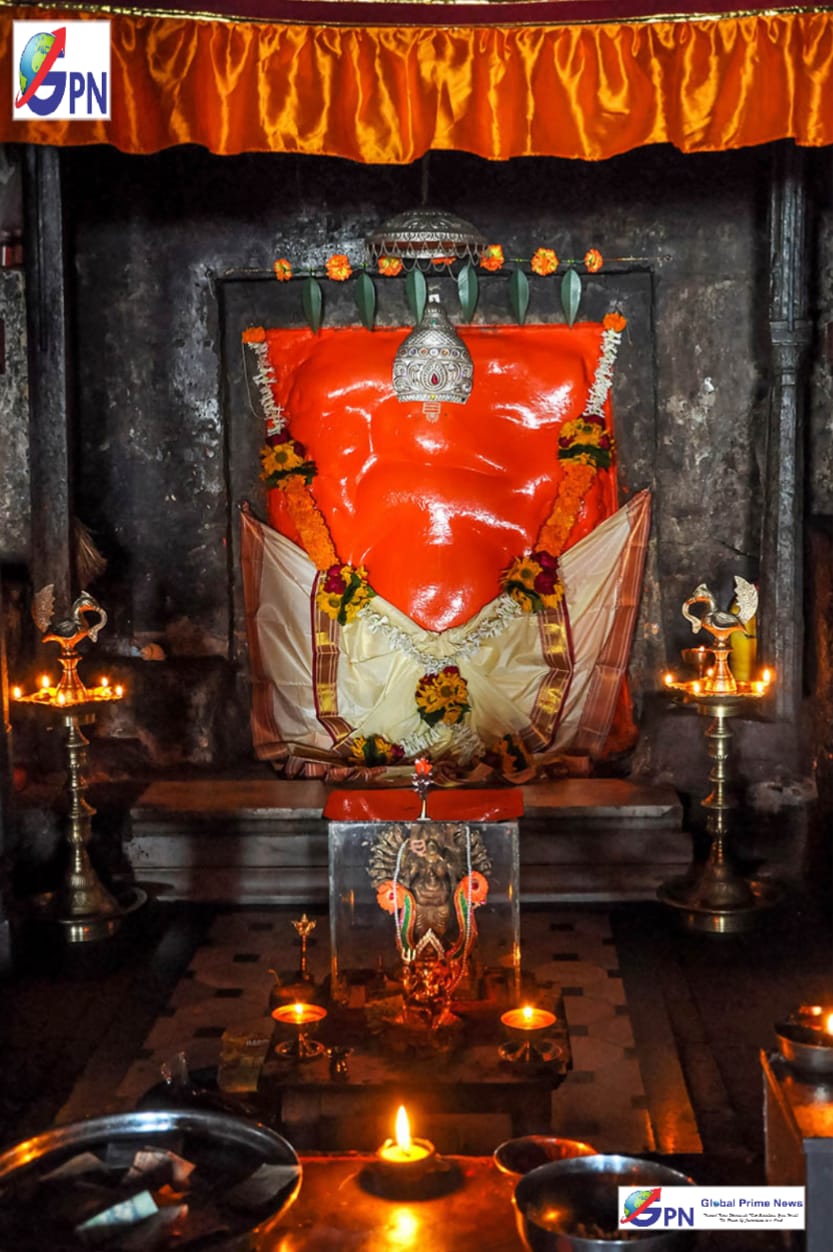
Shri Girijatmaj, Lenyadri- 6th Ashtavinayak -Photo By GPN
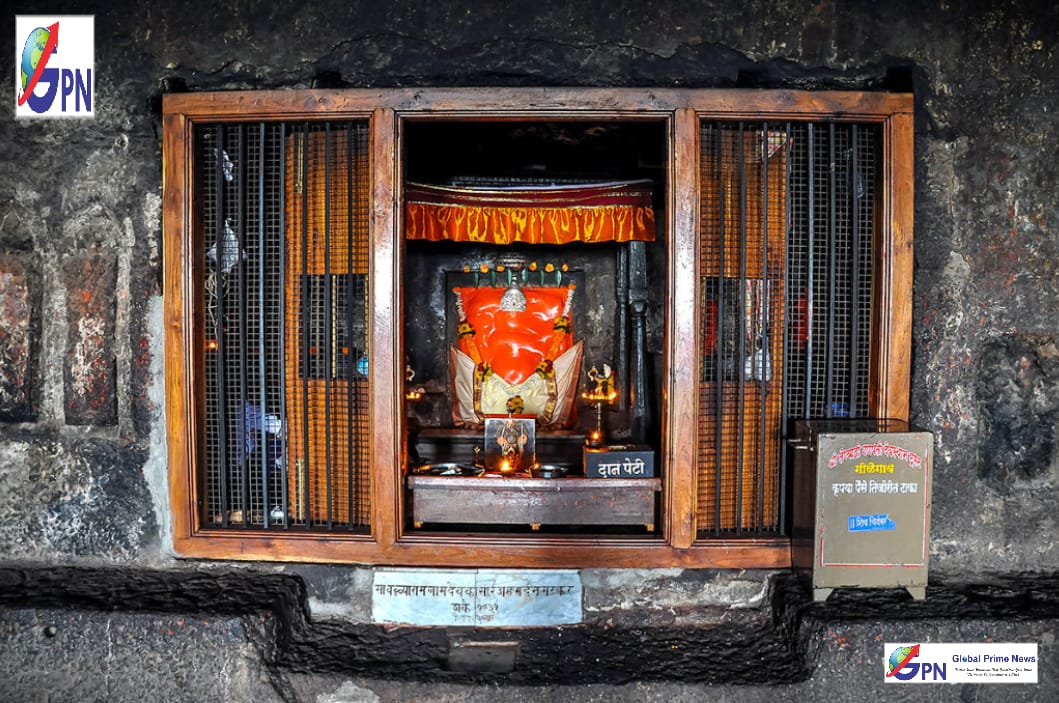
Shri Girijatmaj, Lenyadri- 6th Asthavinayak -Photo By GPN
Ashtavinayak – Girijatmaj Lenyadri
Girijatmaj Vinayak refers to the Ganesh as the son of Parvati. This is the only Ashtavinayaka temple that is build on a mountain and is set in a Buddhist cave temple.
It is believed that Parvati (Shiva’s wife) performed penance to beget Ganesha at this point. Girija’s (Parvati’s) Atmaj (son) is Girijatmaj. This temple stands amidst a cave complex of 18 caves of Buddhist origin. This temple is the 8th cave. These are called Ganesh-leni as well.
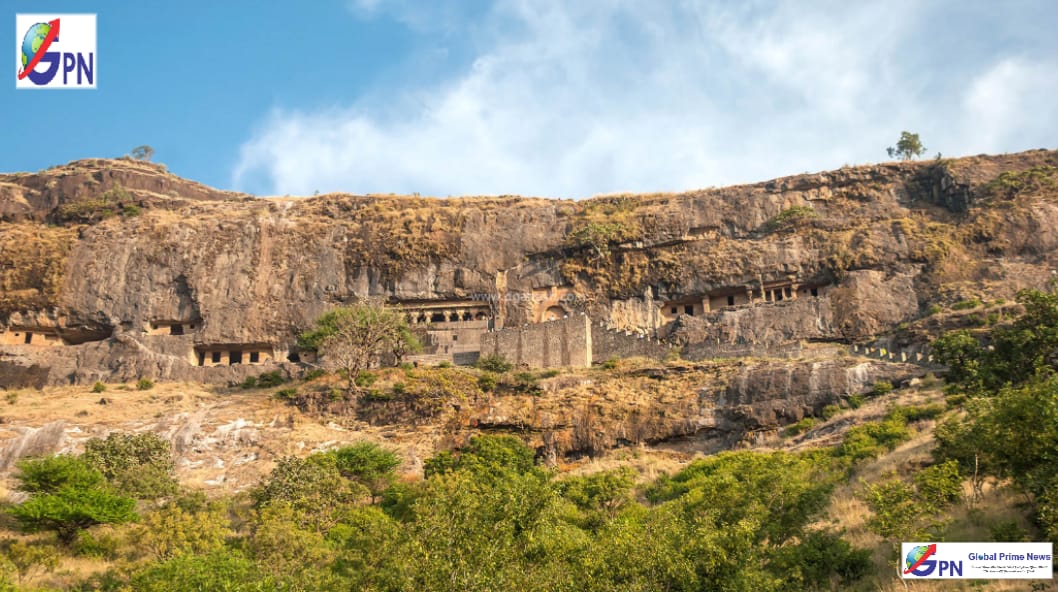
Shri Girijatmaj Temple, Lenyadri- 6th Asthavinayak -Photo By GPN
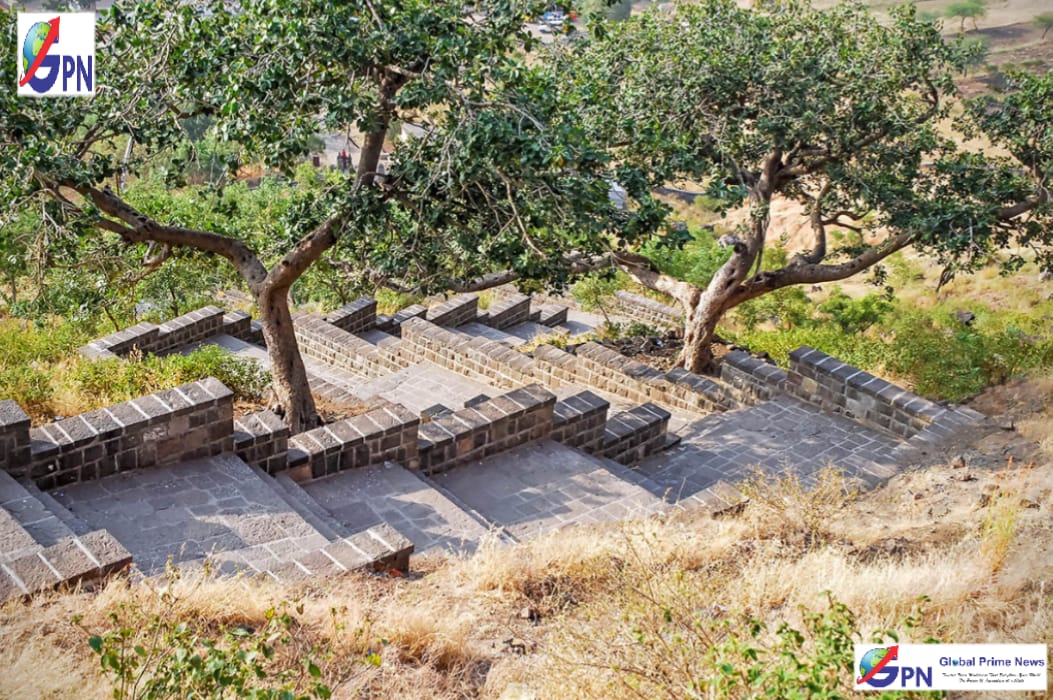
Stairs leading to Shri Girijatmaj Temple, Lenyadri- 6th Asthavinayak -Photo By GPN
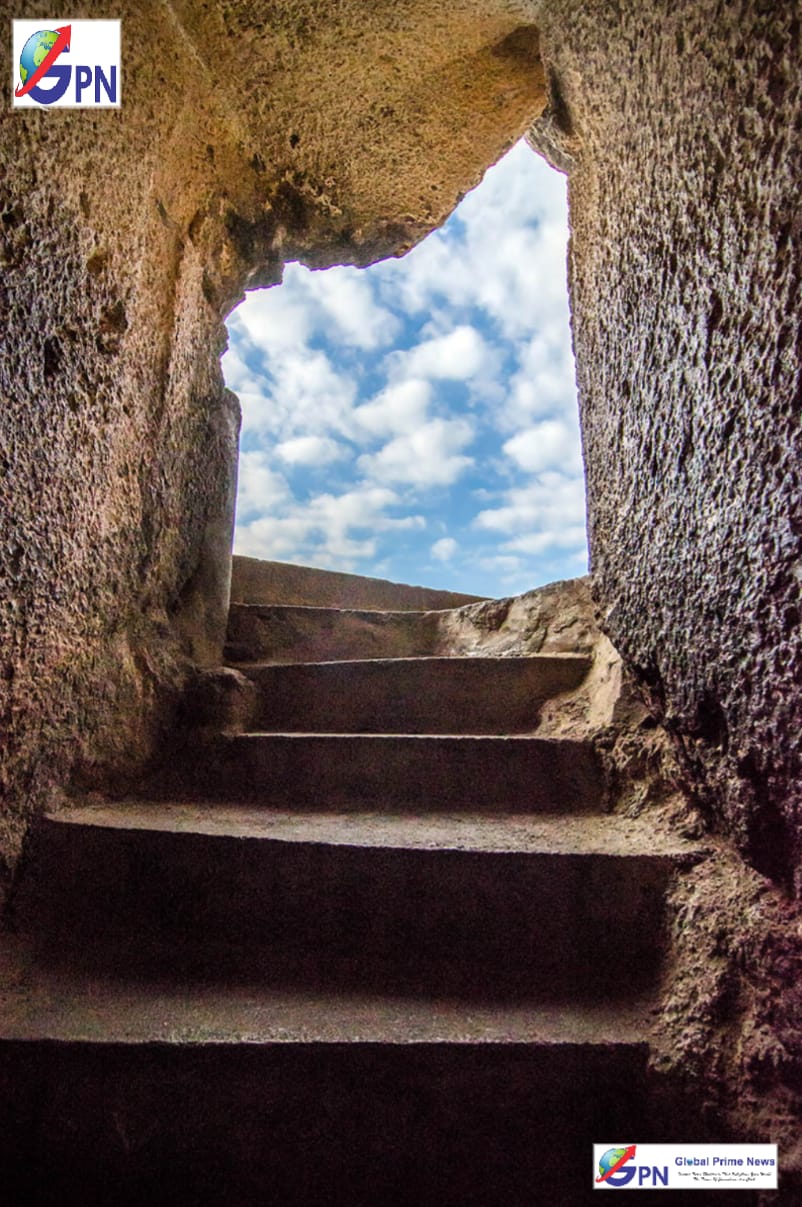
Final steps to Shri Girijatmaj Temple, Lenyadri- 6th Asthavinayak -Photo By GPN
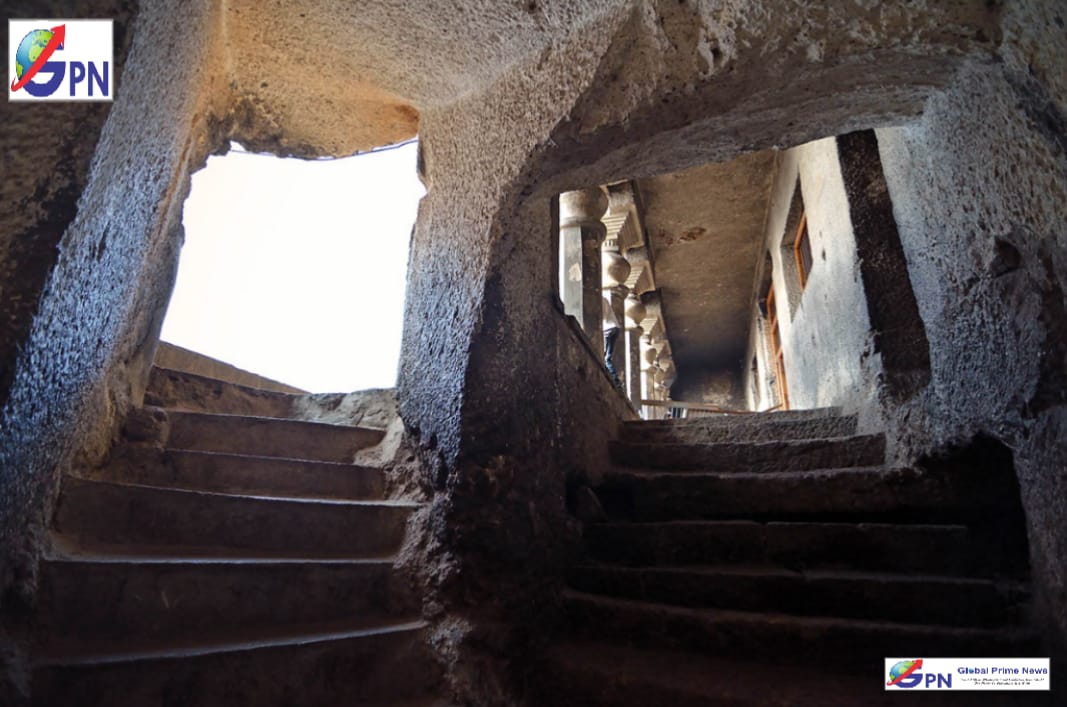
Steps Leading to Shri Girijatmaj Temple, and Buddhist Caves, Lenyadri- 6th Asthavinayak -Photo By GPN
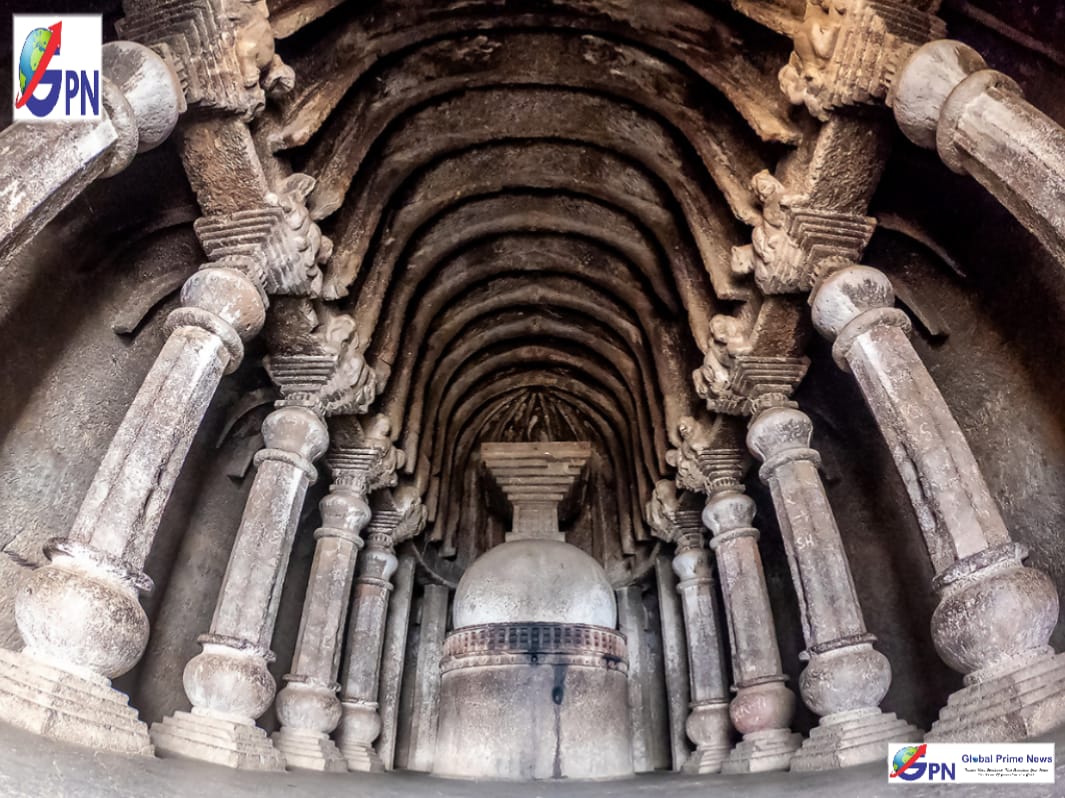
Shri Girijatmaj, Lenyadri- Buddhist Caves for Meditation, Lenyadri- 6th Asthavinayak -Photo By GPN
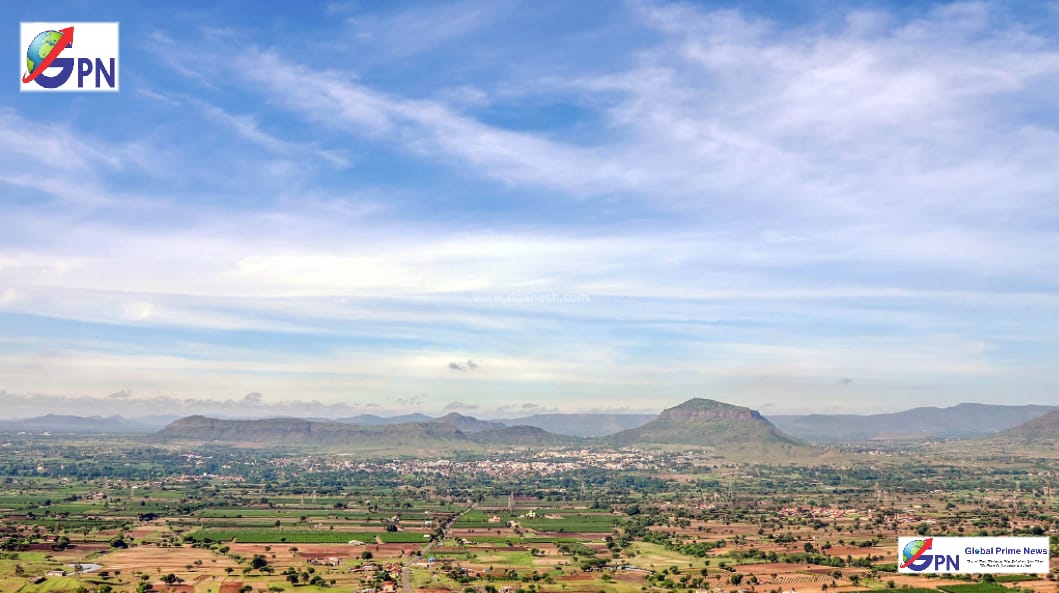
Birds Eye view from Top of Lenyadri- Hills of Shri Girijatmaj Temple, Lenyadri- 6th Asthavinayak -Photo By GPN
The idol faces north with its trunk to the left, and has to be worshiped from the rear of the temple. The temple faces south. This idol seems to be little different from the rest of the Ashtavinayak idols in a sense that it appears to be not very well designed or carved like the other idols. The Girijatmaj Vinayak idol here is not a separate one. It has been carved on a stone wall of the cave. In the earlier days, the idol was covered with armour. Now since the armour has fallen, we can see the neck of the idol turned to the left. As such we can see only one eye of the idol of Girijtmaj Vinayak.
This idol can be worshiped by anyone. There is no electric bulb in the temple. The temple is constructed such that during the day it is always lighted up by the sun-rays!
Girijatmaja Vinayak at Lenyadri hills in Maharashtra is a representation of Ganesha in the form of an infant. There are 283 steps to reach the temple.
The Girijatmaj Vinayak temple of the asthavinayak temples is on the top of a mountain in the eighth of the Buddhist caves. These caves are also called as Ganesh Gufa. The temple of Girijatmaj Vinayak is facing southwards and has been carved out of a single rock. One interesting about this temple is that the Sabhamandap of this asthavinayak temple is 53 feet long and high, but does not have even single pillar to support it. We can see 18 overee (small rooms for meditation) inside the Sabhamandap. The idol of Girijatmaj is in one of these rooms. Any devotee can enter the Garbhagriha at this temple and offer their prayers. Sabhamandap of main temple is only 7 feet high. It has six stone pillars with cow, elephant etc. carved on them. From the main temple one can view river flowing & the Junnar town spread near the river.
We can also see a buddhist stupa just beside the main cave. Another attraction nearby to this Girijatmaj Vinayak temple is the Shivneri Fort where the Chatrapati Shivaji Maharaj was born. There are a total of 18 caves here which are dated back to 3rd century.
Big celebrations are held during the Bhadrapad and Magh Chaturthis. In the month of Magh an Akhand Harinaam Saptah is also held.
Kirthans and other cultural programs are held on Ganesh Jayanthi. Bullock cart racing is also organized on this occasion.
Virtuous deeds like Abhishek, Pooja, Sahastravartan etc. are done by temple trust on behalf of devotees.
7) VIGHNAHAR, OZAR- 7th ASHTAVINAYAK
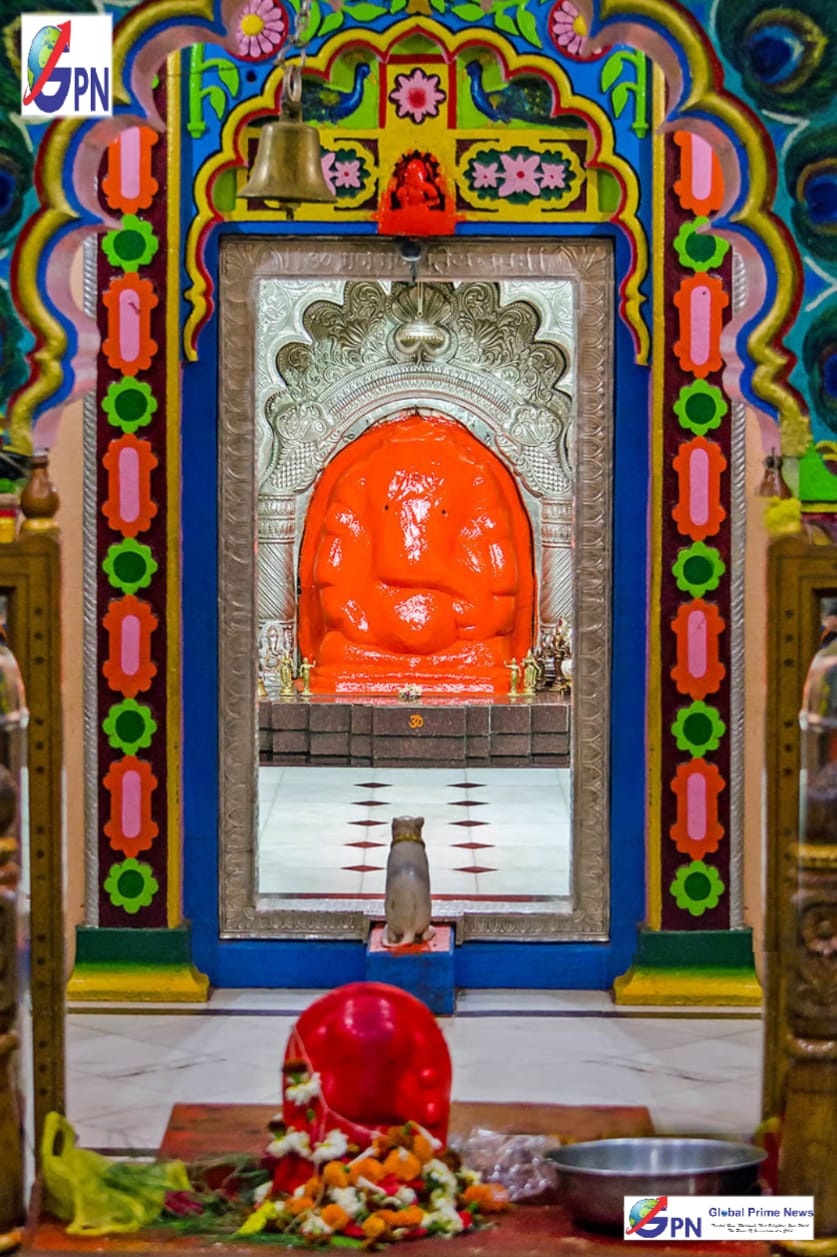 Ashtavinayak – Vighnahar (Vighneshwar) Ozar
Ashtavinayak – Vighnahar (Vighneshwar) Ozar
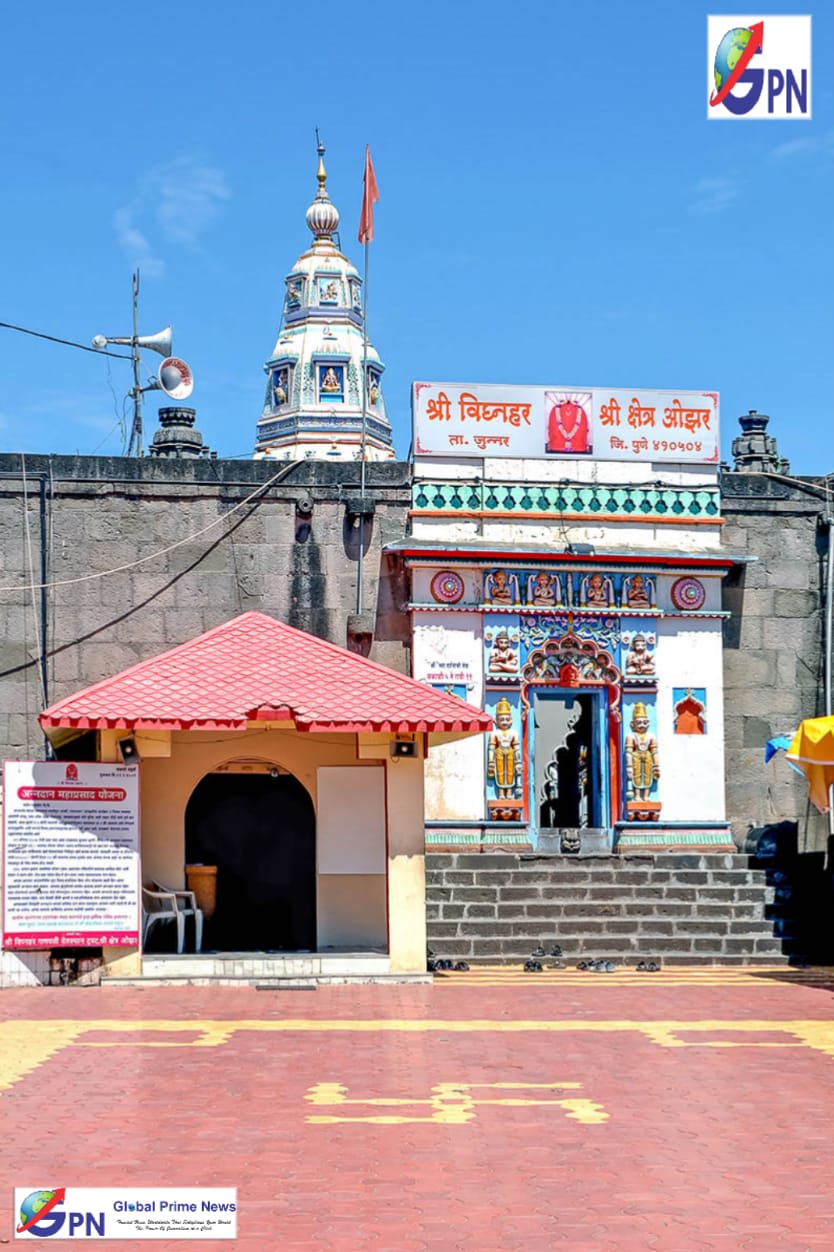 Ozhar is located in Junnar Taluka of Pune District at a distance of 9 Kms. from NarayanGaon. Ozhar is at a distance of 85 Kms. from Pune city.
Ozhar is located in Junnar Taluka of Pune District at a distance of 9 Kms. from NarayanGaon. Ozhar is at a distance of 85 Kms. from Pune city.
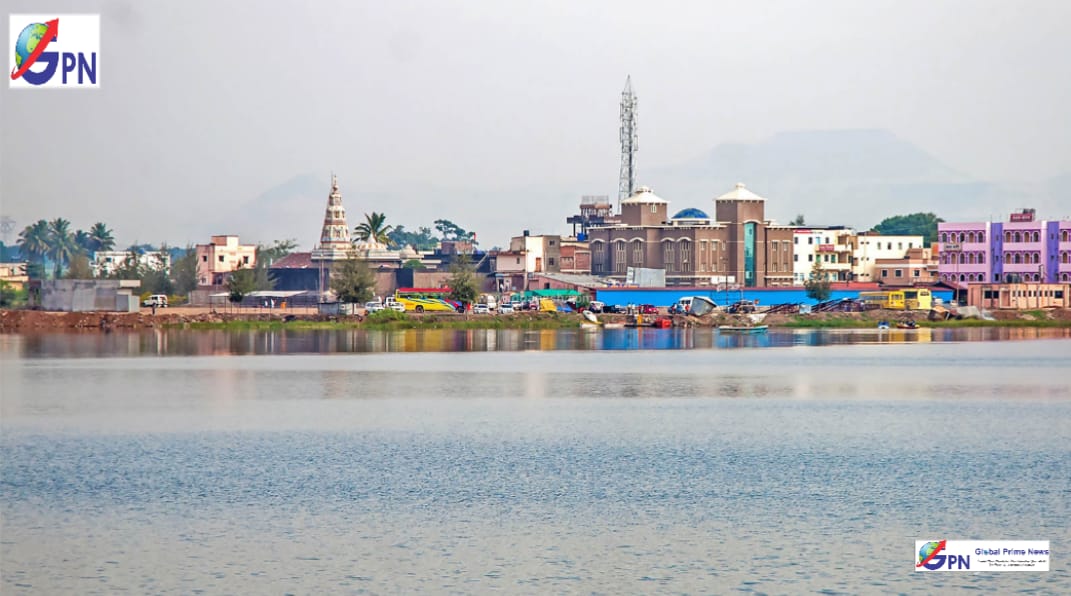
Temple view from the banks of Kukadi River
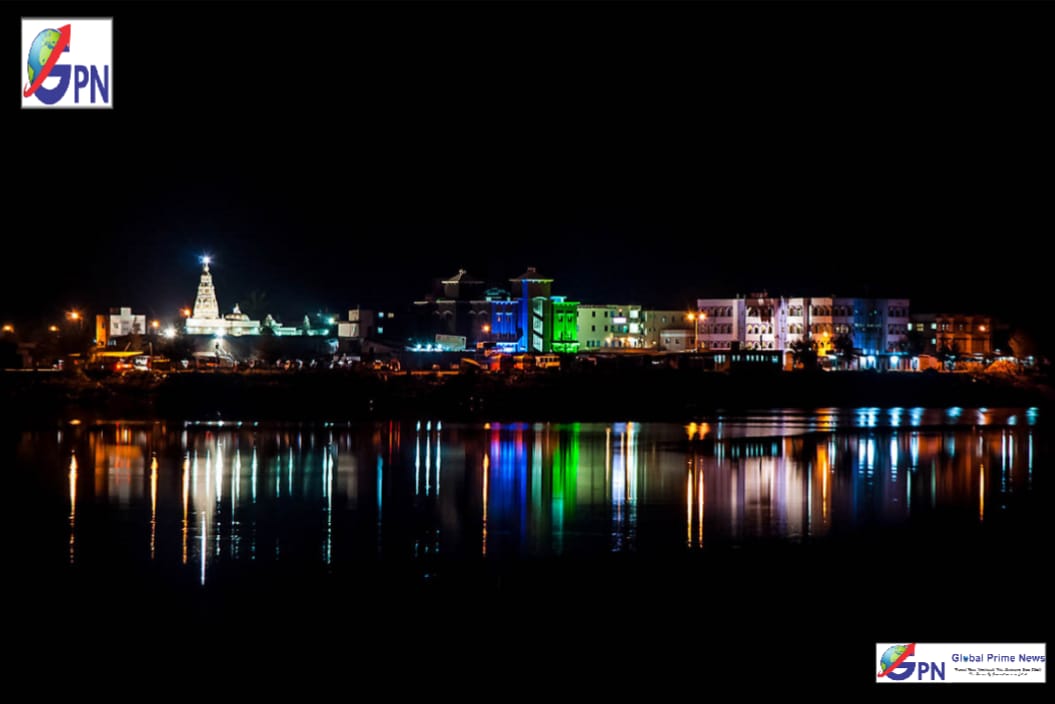
Temple view from the banks of Kukadi River at Night
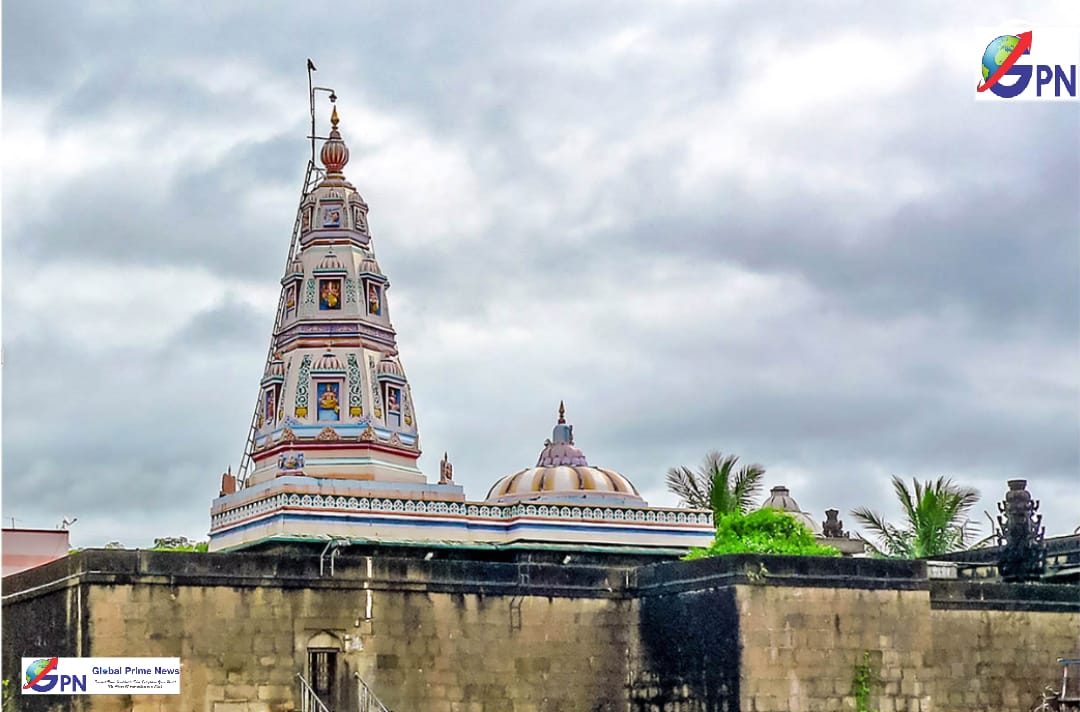
Shri Vignahar Temple Shikar
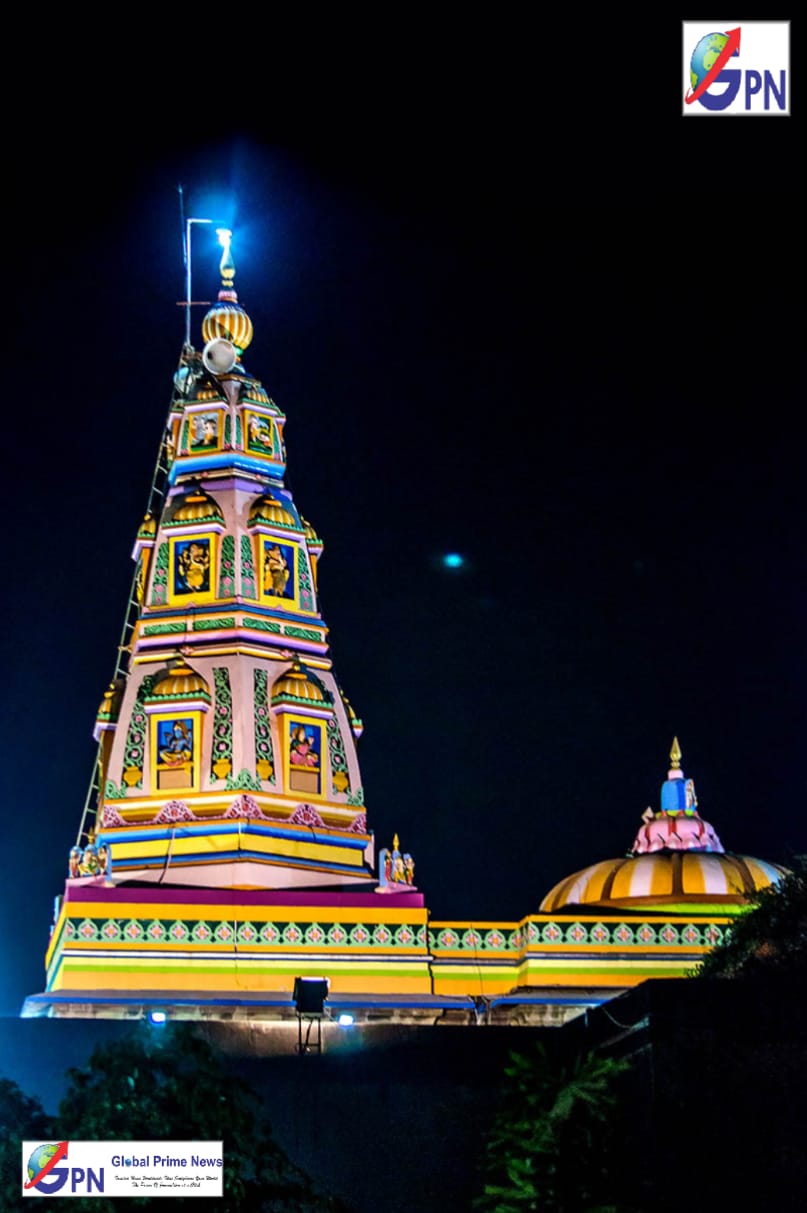
Shri Vignahar Temple Shikar at Night

Entrance Top
Lord Ganesha at Ozhar is known as Vigneshwara or the remover of all obstacles which he achieved by vanquishing the demon Vighnasura.The idol of Vighneshwar Vinayak at Ozhar faces east and his trunk is turned towards left side. The idol which is smeared in vermillion mixed with oil, has two emerald studded eyes and a diamond is there on the forehead and in the navel. We can see brass idols of Riddhi and Siddhi on both sides of idol of Vighneshwar Vinayak. The temple has a golden dome and pinnacle.
The Vighneshwar Viayak temple is enclosed on all the four sides by high stone walls, and its pinnacle is made of Gold. The temple is located on the banks of Kukadi River. The Ganesh at this temple is called as Shri Vighneshwar Vinayak.
The temple of Vighneshwar Vinayak at Ozhar faces east and is surrounded by a thick stone wall. You can even walk on the wall. tanding on this boundary one can see the Lenyadri Mountain where Lord Girijatmaj resides and the Shivneri fort, a historic fort belonging to Shivaji the Maratha King. The main hall of this temple is about 20 feet long and the inner hall is 10 feet long. The temple top is Golden and is possibly built by Chimaji Appa after defeating the Portuguese rulers of Vasai and Sashti. The temple was built around 1785 AD.
At the entrance of the Vighneshwar Vinayak temple, we can see two statues of guards Jay & Vijay who protect the temple. On entering one can see two overris [rooms used for meditation]. The SabhaMandap is 20 feet long and in it is a marble statue of the mooshak[a mouse]- Lord Ganesh’s means of conveyance. All the walls of the temple are covered with attractive and colourful pictures. In the garbhagriha, the sanctum resides the deity. The deity is also facing east and is seated. On both sides of the deity are brass statues of Riddhi and Siddhi.
LEGEND OF SHRI VIGNAHAR
A King called as Abhinandan wanted to become the king of Heaven. To achieve this goal he started a Yagna, a sacrifice. Indra, the king of Heaven heard of this and decided to create obstacles for the Yagna. He called Kalapurush and asked him to destroy the yagna. After doing all this Kalapurush acquired the name Vighnasura, the creator of obstacles. Vighnasura destroyed all vedic practices and religious acts on earth. All the people and sages pleaded for help. The gods realized that they had to destroy this demon Vighnasura and they turned to Ganesha for help, who was at the ashram of Sage Parashar. Then Ganesha took birth as the son of Parshwaputra and his wife Deepvatsala. He then fought violently with Vighnasura and defeated him. After getting defeated, the demon begged for mercy. Ganesha accepted his plea and granted him a wish, but on the condition that the demon should not enter the place where Ganesha is being worshiped. Vighnasura accepted this on condition that Lord Ganesh be known by his name and wished that his name should be placed before Ganesh. So Lord Ganesh came to be known as Vighneshwar Vinayak or Vighnaharta Vinayak.
Festivals celebrated at Vighneshwar Vinayak temple Ozhar
Big celebrations are held at Vighneshwar Vinayak temple at Ozhar during the Bhadrapad and Magh Chaturthis. From Tripura Purnima that is from the full moon day of the month of Karthink, a four day festival is celebrated at the Vighneshwar vinayak temple at Ozhar. The entire temple is lit at this time and we can see thousands of devotees visiting Vighneshwar Vinayak during this time and take blessings from the lord.
8) SHRI MAHAGANAPATI, RANJANGOAN – 8th ASHTAVINAYAK
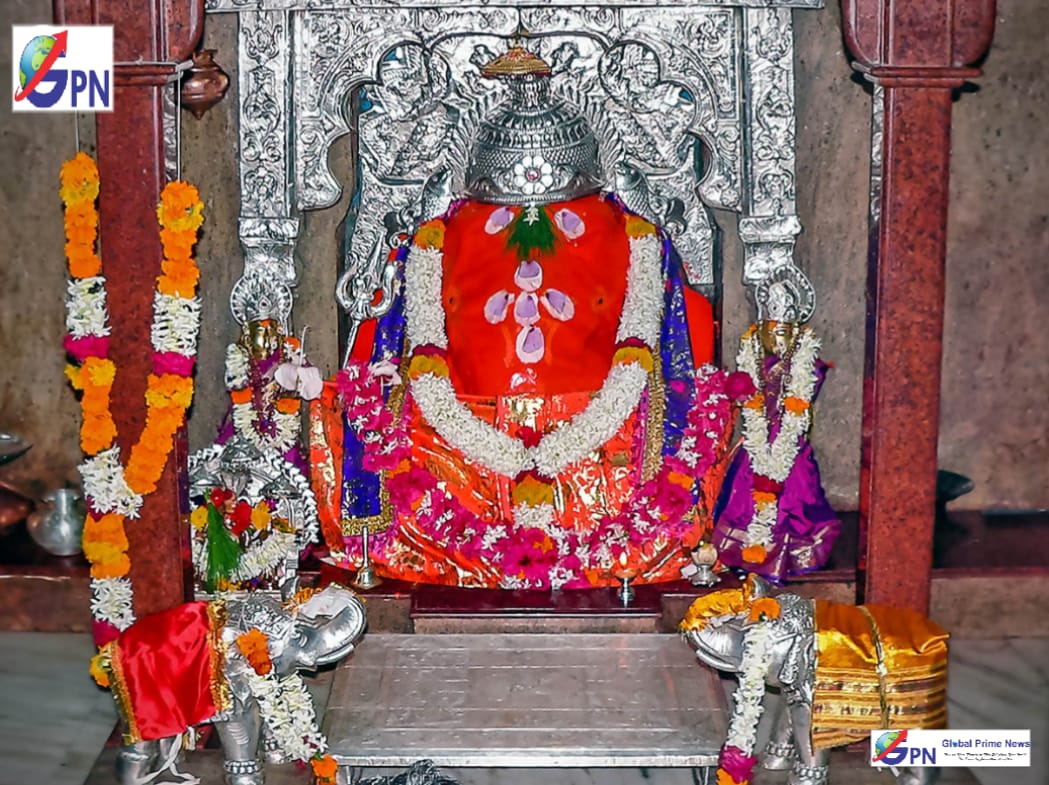 Ashtavinayak – Mahaganpati Ranjangaon
Ashtavinayak – Mahaganpati Ranjangaon

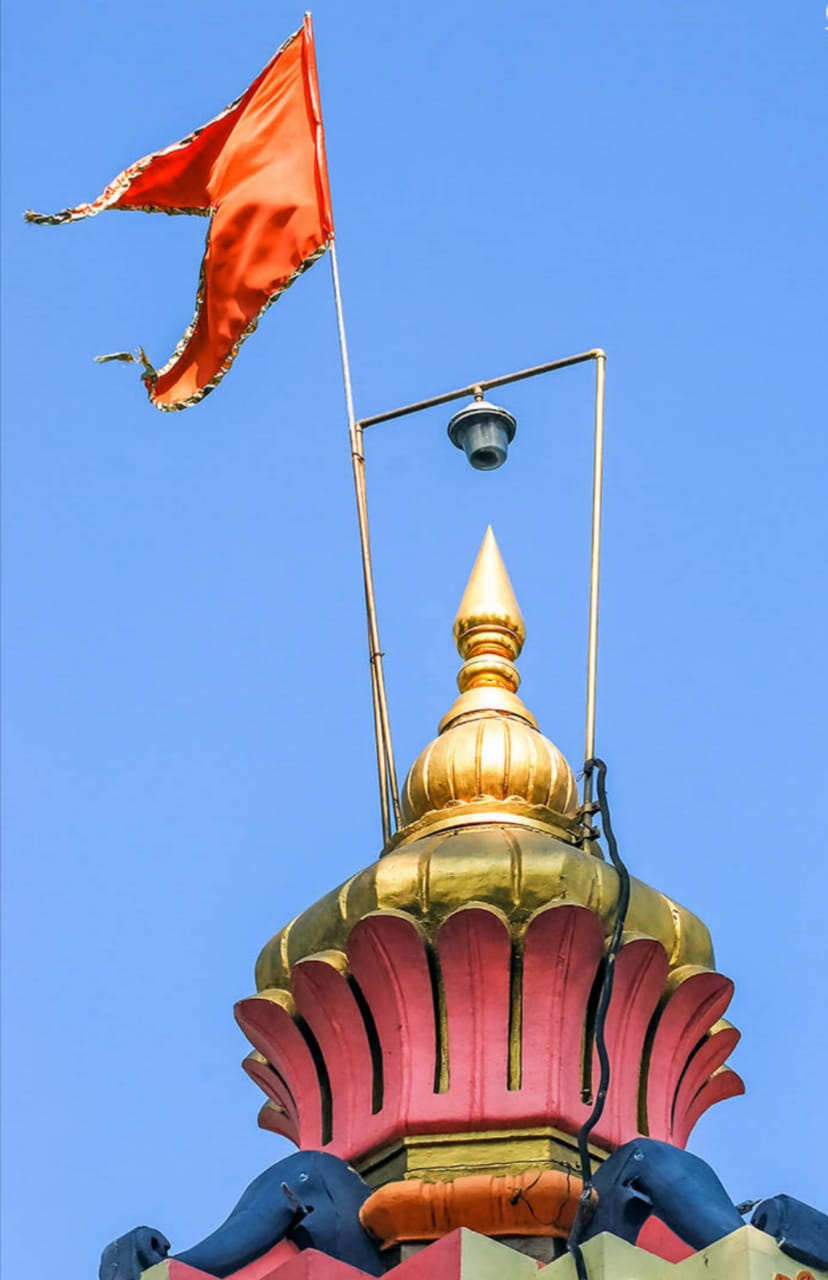
Dhwaj and Shikar at Shri Mahaganapati Ranjangaon

Grand Main Entrance

Way to Main Sanctrum
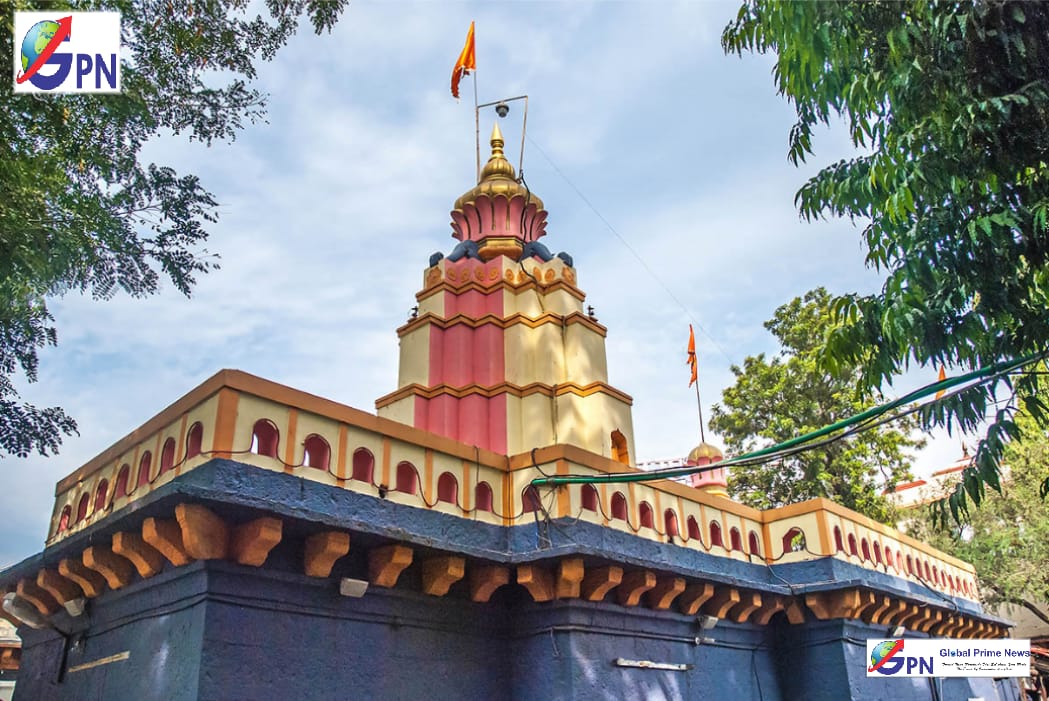
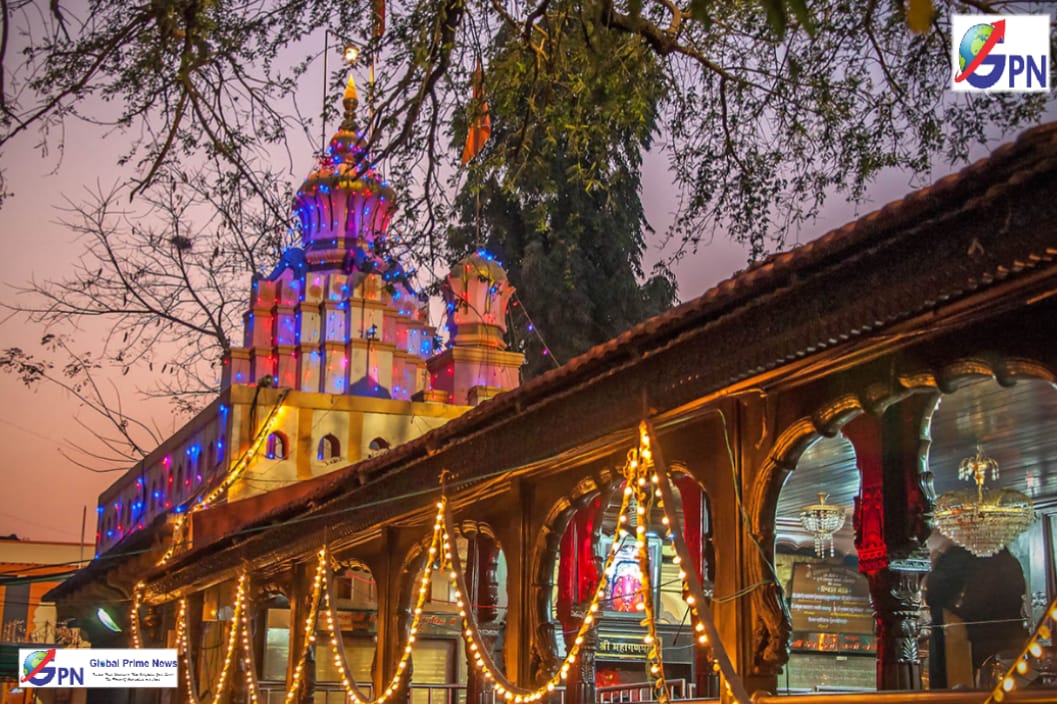
Evening time photo
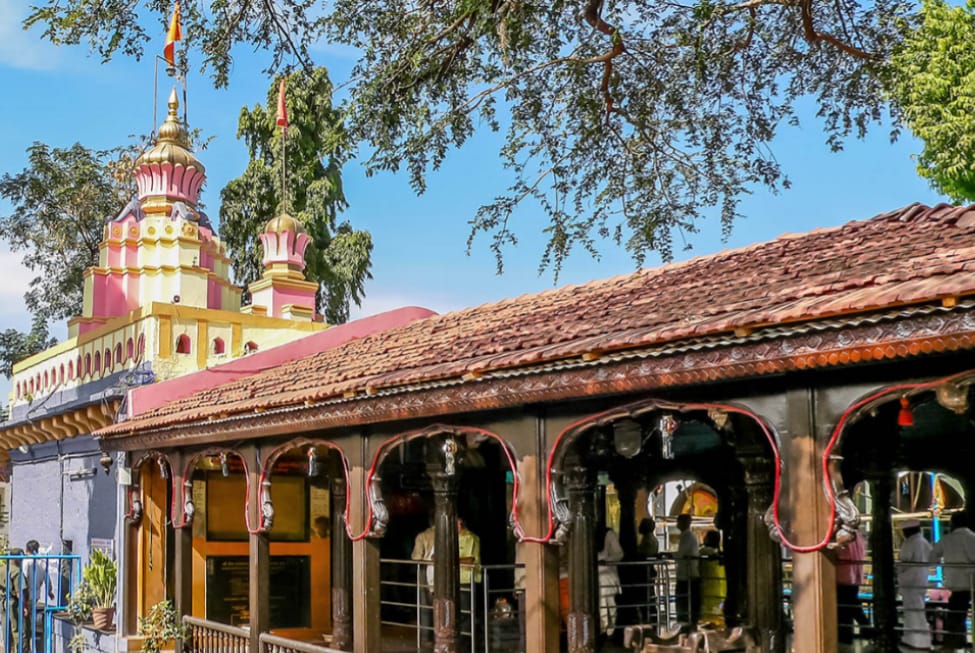
The Mahaganapati at Ranjangoan is one of the most powerful representations of Lord Ganesh. Here Shiva is believed to have worshipped Ganesha before fighting the demon Tripurasura. It is the eighth and last Ganesh Temple to be visited during the Ashta Vinayaka Temple Pilgrimage.
The idol faces the east, is seated in a cross-legged position with a broad forehead, with its trunk pointing to the left. The temple was built by Shiva to worship Ganesha and the town he set up was called as Manipur which is now known as Ranjangaon. It is said that the original idol is hidden in the basement, having 10 trunks and 20 hands and is called Mahotkat, however, the temple authorities deny existence of any such idol.
Mahaganapati is portrayed, seated on a lotus, flanked by his consorts Siddhi and Ridhi. The temple dates back to the period of Peshwa Madhav Rao.The temple was built by Sardar Kine. The temple of Maha Ganpati is very close to the centre of the town Ranjangaon. The temple was erected during the rule of the Peshwas. Peshwa Madhavrao had constructed the inner sanctum, to house the swayambhoo (naturally found) idol.
The Mahaganapati Temple, Ranjangaon is east facing and has a huge and beautiful entrance gate. The Idols of Jay and Vijay are present near the gateway. The Nagarkhana is situated above the main entrance gate which was inaugurated by Maharashtra’s honourable chief minister Shri Manohar Joshi in the year 1997. The temple is designed in such a way that during Dakshinayan the rays of the sun fall directly on the deity.
LEGEND:Tripurasur is the son of Sage Gritsamad. One fine day this sage sneezed and a boy was created from this whom he brought up as son. Sage taught the boy the Ganesha mantra. This boy meditated very intensely on Lord Ganesha who blessed him and was given three pura-s of gold silver and iron. Since he was the owner of these three pura-s, he was given the name of Tripura. Lord Ganesh blessed him that he will be powerful and only Lord Shiva can destroy him and after being destroyed by Lord Shiva, he would attain the salvation. So Tripura was proud due to this boon and started troubling the entire world. He conquered all the worlds and started to conquer the heaven. He was so aggressive that even Lord Brahma had to hide in a lotus and Lord Vishnu in the Kshirsagar. He conquered even Lord Shiva’s Kailash parvat and so became the king of all the three worlds. Narada advised gods to medidate on Lord Ganesha. So Ganesha decided to help the gods to conquer Tripura.
Lord Ganesha then disguised as brahmin and visited Tripurasur and told him that he was a Brahmin and could make for him three flying planes. Riding these he would make him to go anywhere he wished within minutes. The planes can only be destroyed by Shiva. Lord Ganesh in return asked him to get the statue of Chintamani which was at Kailash Mountain. Tripurasura tried to get it from Kailash Mountain but Lord Shiva refused to give the statue to him. Then Tripurasura got angry and he started fighting with Lord Shiva to get the statue. He destroyed everything that belonged to the Lord Shiva.
Lord Shiva then came to know that he was unable to destroy Tripurasur because he had not paid his respects to Lord Ganesh. Lord Shiva then chanted the Shadaakshar Mantra to invoke Ganesh. On doing so, Gajanan emerged from his mouth. Gajanan helped Lord Shiva on how to kill Tripurasur. Lord shiva finally could kill Tripurasur. A temple was created by Lord Shiva where he invoked Lord Ganesha. The town surrounding this place was called as Manipur. The village of Ranjangaon is the place where Lord Shiva himlself sought the blessings of Lord Ganesh and destroyed Tripurasura.
Puja Schedule at Mahaganapathi Vinayak temple at Ranjangaon
The Maha Ganapathi Vinayak temple is open from 5:30 AM to 10:00 AM. The Devotees can offer pujas like Abhishek, Sahastravartan and Satya Vinayak Puja which cost Rs.11/-, Rs.101/- and Rs.51/- respectively. The temple trust also arranges for the Prasad to be sent to devotees.
Festivals celebrated at Maha Ganapathi Vinayak temple at Ranjangaon
One important thing about the Ranjangaon village is that while the whole country celebrates the Ganesh Chaturthi festival in their own homes by bringing the idols of Ganesh to their homes, the residents of Ranjangaon village do not bring the idols of Ganapathi to their homes during the Ganesh Chaturthi festival. All the villagers come to the Maha Ganapathi Vinayak temple on the day of Ganesh Chaturthi.
In the month of Bhadrapad, a festival of six days is celebrated from the Pratipada to the Sashti, that is from the first to the sixth of the waxing period of the month. There is a “Mahaprasad” on fifth day which is a big offering to Lord Maha Ganapati. The Deity’s palki procession is conducted on these days. Other celebrations like wrestling matches are also conducted. ENDS
NOTE: These Ashtavinayak temples are 1)Moreshwar – Moregaon, 2) SiddhiVinayak-Siddhatek, 3) Ballaleshwar-Pali, 4) VardaVinayak- Mahad, 5) Chintamani-Theur, 6) Girjatmaj-Lenyandri, 7) Vignahar or Vigneshwar -Ozar, 8) Maha Ganapati – Ranjangaon and then again Moregaon.. These places are at Pune, Ahamadnagar and Raigad district.
These are the eight temples of Ashtavinayak in its sequence. Why to follow this sequence is revealed in the Shloka in Sanskrit:
The following shlok tells the same.
स्वस्ति श्री गणनायकंगजमुखं मोरेश्वरम सिध्दिदम |
बल्लाळम, मुरुडं, विनायक – मढंचिंतामणी थेवरम |लेन्यांद्री गिरिजात्मज सुवर्दमविघ्नेश्वरम ओझरम |
ग्रामो रांजण संस्थितो गणपती :कुर्यात सदा मंगलम ||
As there is a belief that to complete the yatra, one must return back to the first temple of Moreshwar in Morgaon to compete it. Every devotee of Lord Ganesh makes it a point to visit all the holy temples….
GANAPATI BAPPA MORYA!!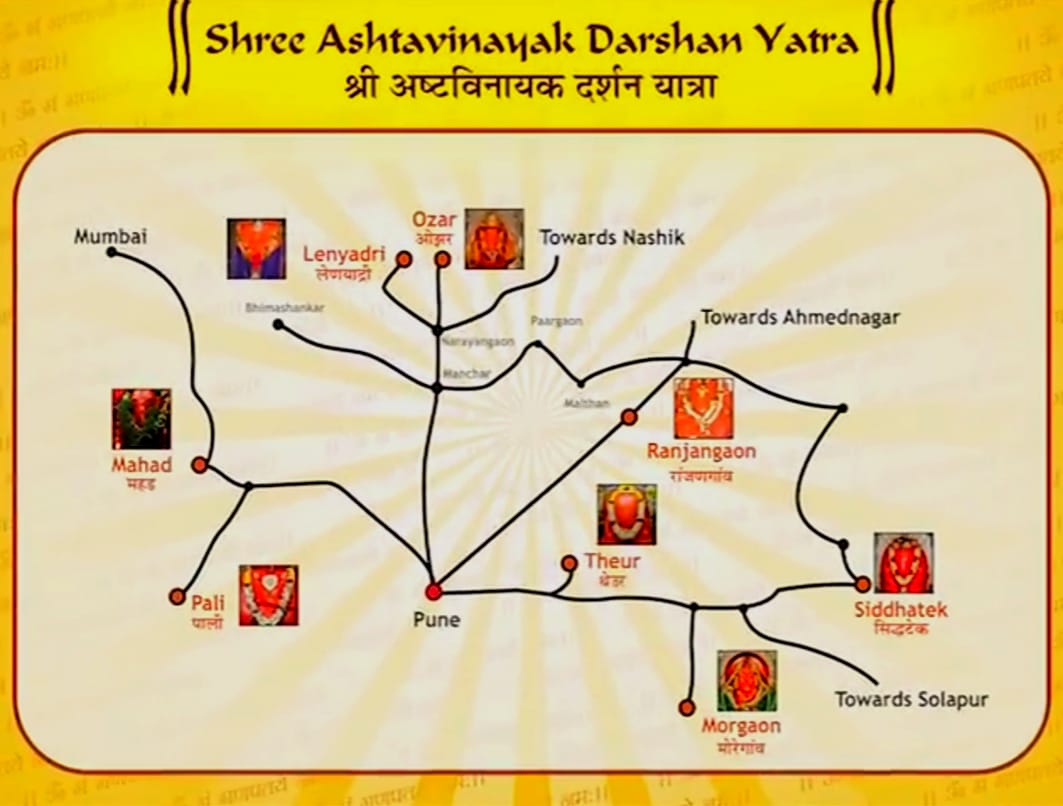

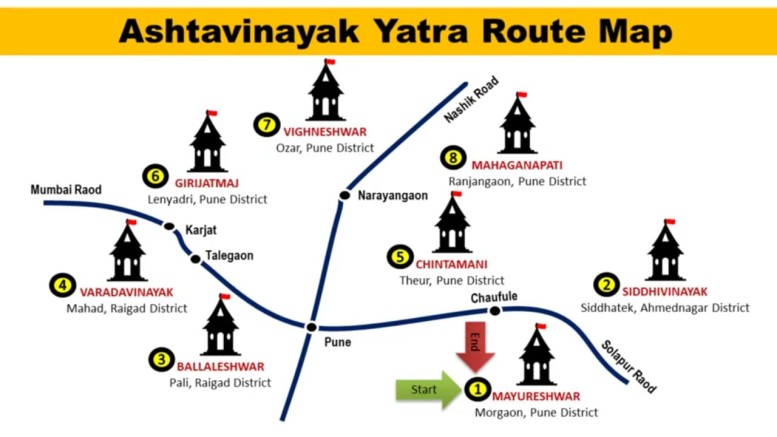
Be the first to comment on "Shree Ashtavinayak Yatra Virtual Darshan with AV of the Eight Highly Auspicious Shrines of God Ganesh-A must visit temples of India!"